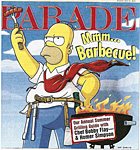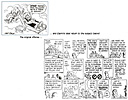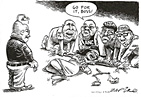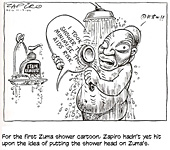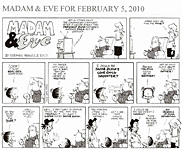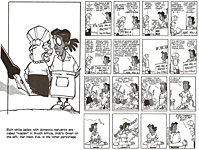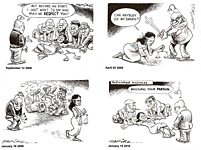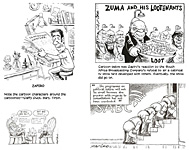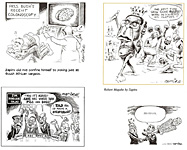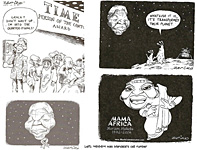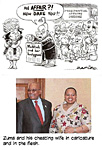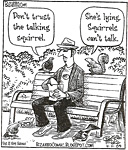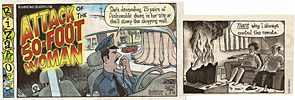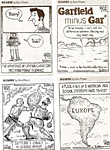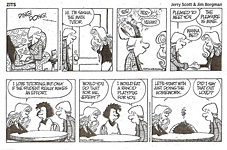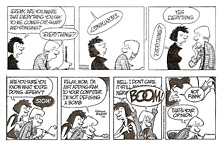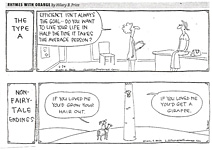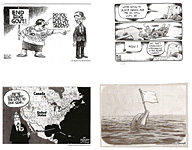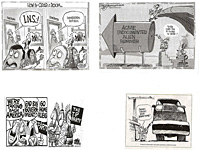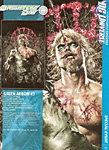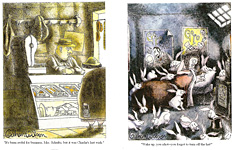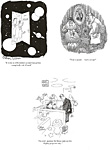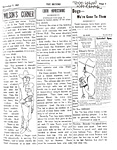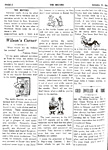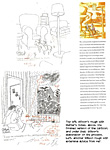 |
|||||||||||||||||||
Opus 263 (June 16, 2010). Four big stories this time: in-depth (not to say exhaustive) examination of the Day of Effigy and the whole problem of drawing Muhammad, which, it turns out, is counterproductive; South Africa=s editoonist Zapiro, his Muhammad adventure and why President Zuma deserves a shower; this year=s NCS Reuben and category winners listed and kvetched about; and a long review and appreciation of Gahan Wilson=s Playboy cartoon retrospective. And more. Here=s what=s here, in order, by department:
NOUS R US Comics at BookExpo America Marmaduke Movie Arouses Cautions Comic-Con Documentary AJC@ at Comedy Central
HOMER FOREVER Mark Fiore and Steve Jobs
DAY OF EFFIGY: PART TWO Spread of Boycott South Africa=s Zapiro Zapiro=s Newspaper Meets a Muslim Committee Cartooning Muhammad Is Counterproductive
ZAPIRO BIOGRAPHY & GALLERY President Zuma, A Cartoonist=s Dream Come True
Sunday Funnies on Postage Stamps Ted Rall Goes Back to the >Stans
PONDERING IDOLATRY AND OTHER MISCHIEFS Live and Let Live
REUBEN AWARDS Dan Piraro Wins the Reuben Category (Division) Winners Listed Gripes and Crotchets
THE FROTH ESTATE The Week Magazine
EDITOONERY Oil and Aliens
CIVILIZATION=S LAST OUTPOST How the Texas Tail Wags the Dog PETA=s Cripple Chicken
BOOK MARQUEE Sunday Press= Krazy Kat Tome
FUNNYBOOK FAN FARE Black Widow, Mark Schultz and Moritat on the Spirit, Green Arrow Cover
BOOK REVIEW Three-volume Gahan Wilson Playboy Cartoons Collection
PASSING THROUGH Tony DiPreta, 1922 -2010 Bernard Schoenbaum, 1920 - 2010
UNDER THE SPREADING PUNDITRY Why Laws Passed by Congress Don=t Work Myths about Immigration Reform Are Incumbents Really An Endangered Species?
And our customary reminder: don=t forget to activate the ABathroom Button@ by clicking on the Aprint friendly version@ so you can print off a copy of just this installment for reading later, at your leisure while enthroned. Without further adieu, then, here we goC
NOUS R US Some of All the News That Gives Us Fits A number of major comics publishers didn=t attend this year=s BookExpo America the last week in MayCDC Comics, Top Shelf, and Drawn & Quarterly; and Scholastic, lately into graphic novels, was also absent. But there was a Agraphic novel row@ hosted by Diamond Book Distribution and featuring exhibitors Dark Horse, IDW, Dynamite, Paizo, Image/Top Cow, Japanime, and Marvel, reported Douglas Wolk at PublishersWeekly.com. Even if BEA wasn=t Aas gaga over graphic novels@ as it was last year, comics were still a solid albeit subdued niche, according to Calvin Reid and Heidi MacDonald. Bestselling prose authors continue to migrate to the comics medium, said Ada Price, writing original works in collaboration with cartoonists and overseeing the adaptation of their own prose works into graphic novels. Dark Horse's upcoming publication of Janet and Alex Evanovich's Troublemaker, the bestselling novelist's first foray into comics, Awas easily the big graphic novel of the show,@ continued Reid and MacDonald, and such publishers as NBM, W.W. Norton, Pantheon, Fantagraphics, IDW, Image Comics, Abrams and Bloomsbury USA all featured significant comics works for summer and fall release. Donald Duck was 69 years old on Wednesday June 9, 2010. He began his trademark enraged squawking and sputtering in Disney=s 1934 AThe Wise Little Hen,@ the first of 128 cartoons in which he has appeared. ... The original Lois Lane was on hand to help unveil a statue immortalizing the Superman character at the Superman Festival in Metropolis, Illinois on June 11. AThe statue,@ according to kfvs12.com, Alooks like Noel Neill who played Lois Lane on the old Superman tv series.@ The annual Superman Festival attracts thousands of people from all over the country and lasts through the weekend. ... Even as Little Ophan Annie disappeared from the funnies pages on June 13, the invincible tot is due to return to Broadway. The Associated Press reported that plans are afoot to mount a production of the Tony Award-winning musical AAnnie@ in the fall of 2012. On June 12, Over the Hedge passed the 15-year marker. Created by Michael Fry and T (no period because that=s so ordinary) Lewis, who draws it, the comic strip, which appears in 250 newspapers, examines suburban life from the perspective of the critters who lived there first when the locale was all woodsy and bushy. Said Lewis in a syndicate press release announcing the anniversary: AIf 12-year old T Lewis could have known what the grown up T Lewis would get to do, his mind would=ve melted. From bringing Mike=s words to life, to joining in the lives of RJ and Verne and Hammy, to nudging black and white lines together to create a unique world, working on Over the Hedge has daily been a childhoodCand adulthoodCdream come true.@ Lewis also illustrates books. On June 4, Brad Anderson=s lovable Great Dane, Marmaduke, joined the parade of comic characters going into the movies: he leapt to the big screen from the 600 newspapers he presently appears in as the hero of a panel cartoon weekdays, a comic strip on Sundays. In Canada, the new movie has generated Aconcerns@ in the Calgary Humane Society, which fears that unprepared animal lovers will want a Dane of their own, reported Jenna McMurray at TorontoSun.com. ASpokeswoman Lindsay Jones said animal movies, such as >101 Dalmatians= and the guinea pig flick >G-Force,= have launched crazes in the past, prompting some people to purchase new pets without doing proper research. >It becomes a fad or a trend,= said Jones, adding that pets proving to be too much for impulsive owners usually wind up in shelters.@ Everybody wants into the protest business. This year's Comic-Con International at San Diego, the 41st of this annual geekfest, will be filmed for a documentary by director Morgan Spurlock (ASuper Size Me,@ AWhere in the World is Osama Bin Laden@) and a team of producers including Marvel Comic's icon Stan Lee and Joss Whedon (ABuffy the Vampire Slayer@ writer/director). Entitled "Comic-Con Episode Four: A Fan's Hope," the documentary, quoth independent.co.uk, will follow seven people from around the world attending the Con July 21-25. Stan Lee, naturally, rejoiced and indulged in a little deserved back-patting: "Many of our highest-grossing movies, best selling toys and most popular video games owe their existence to the increasingly influential comic book." From Noah Fliesher at Heritage Auctions we learn that the original Frank Miller cover art for Daredevil No. 188 (1982), from near the end of Miller=s run on the titleCthe run that established him as a masterful new talentCsold for a world record public auction price of $101,575 on Friday, May 21, as part of Heritage Auctions= $3.2+ million Signature Comics & Comic Art Auction. At another Signature sale earlier in May, a copy of Robert Crumb=s Zap No. 1, graded 9.4 (Near Mint on a 10-point scale), sold for $26,290, a new record for the underground book. Said Heritage operations director Barry Sandoval: AI don=t think it=s kicking off any trend in underground comics being a hot investment, but Zap No. 1 could be considered the underground equivalent of Action Comics No. 1.@ In other Frank Miller news, a Aprequel@ to the artist=s celebrated 300 is under construction. Entitled Xerxes, it is a much more ambitious tale. "The story will be the same heft as 300 but it covers a much, much greater span of time: it's 10 years, not three days," Miller told the L.A. Times. Dark Horse will begin releasing the six-issue tale next year. And if this series is as "awesome and compelling" as the first, Zack Snyder, director of the movie A300,@ said he=d be interested in translating it to the big screen. Comedy Central's plan to develop an animated show about Jesus Christ has rattled the cages of religious watchdog groups, who=ve banded together to protest. The Family Research Council, the Catholic League, the American Alliance of Jews and Christians, and the Parents Television Council (among other groups) coalesced into the Coalition Against Religious Bigotry (CARB). AJC,@ the project under development, contemplates a character named Jesus trying to live as a regular guy in New York City and wanting to escape the shadow of his "powerful but apathetic father." AUnder development,@ as the Irish Times pointed out, Ameans it's still a couple of steps from getting the green light as a series.@ But CARB is already on the attack, urging advertisers to boycott the show and the network: "After we reveal the vile and offensive nature of Comedy Central's previous characterizations of Jesus Chris and God the Father, we expect these advertisers to agree wholeheartedly to end their advertising on Comedy Central and discontinue their support for unabashed, anti-Christian discrimination," Brent Bozell, president, Media Research Centre, said in a statement. "Why should they be supporting a business that makes a habit of attacking Christianity and yet has a formal policy to censor anything considered offensive to followers of Islam? This double standard is pure bigotry, one from which advertisers should quickly shy away." Comedy Central had no comment. After spending $4 billion to acquire Marvel Entertainment last year, says the Hollywood Reporter (Eriq Gardner), Walt Disney Co. Ais now weighing in on a case that threatens some of the company's most lucrative intellectual property. On May 24, Disney filed a memo in support of Marvel's attempts to dismiss copyright claims by the Jack Kirby estate. Family members of the comic book eminence are attempting to terminate a copyright grant to Marvel on such valuable works as Iron Man, X-Men, the Incredible Hulk and Spider-Man. ... The court papers also take up such issues as whether Kirby's original artwork should be turned over, whether Kirby should have been credited in connection with >The Incredible Hulk= and >X-Men= films. Disney also believes the Kirby estate claims are barred by statute of limitations.@ In the latest issue of Diamond=s Previews catalog, the distributor lists the top 100 sellers based upon sales invoiced in April. Marvel is clearly the dominant publisher with 35 of the top 50; 57 of the total. DC has more titles in the Abottom 50" but not more than Marvel: they rack up just 22 each. The only publisher other than Marvel and DC to show up in the top 50 is Dark Horse with Buffy the Vampire Slayer No. 34. Dark Horse appears again the Abottom 50,@ once. Image gets two mentions in the Abottom 50"; Dynamite Entertainment, another two. No other publisher made it into the top 100.
HOMER FOREVER Entertainment Weekly=s cover story for June 4/11 is AThe 100 Greatest Characters of the Last 20 Years,@ and the biggest picture on the cover is of Homer Simpson. Of the 100 characters listed inside, 10 are cartoon characters. That=s 10 percent of this roll call of greatness, kimo sabeCattesting to the power and status of cartoon characters in modern American culture. Or in Entertainment Weekly anyhow. Here they are: at No. 80, Gorillaz (a British mash up of cartoon characters and pop music), Jimmy Corrigan (62), Stewie Griffin (45), Beavis and Butt-Head (32, from 1996), Kavalier & Clay (26, from Michael Chabon=s Pulitzer-winning novel), Woody (25, star of AToy Story@), ASouth Park=s@ Cartman (22), Spongebob Squarepants (10), The Joker (5, as played by Heath Ledger), andCfanfare, bugles, trumpets, wurlitzer CHomer Simpson at No. 1, The Greatest character of the last 20 years! The write-up about Homer, by Dan Snierson, starts: AHe rages against inanimate objects. He gets into arguments with his own brain. He has forgotten the names of family members. (>There=s five of us: Marge, Bart, girl Bart, the one who doesn=t talk, and the fat guy. How I loathe him.=) He=s eaten everything from a hot dog at the bottom of a kiddie pool to a jar of petroleum jelly. He=s lazy, rash, and incompetent, not to mention a tragic speller (>I am so smart! S-M-R-T!=). These are not good qualilties in a mate, friend, co-worker, or dad. They can, however, make for great comedy. For that reasonCand hundreds moreCEW is naming Homer Simpson the No. 1 character in pop culture in the last 20 years.@ Snierson quotes Dan Castellaneta, who has voiced Homer for 21 seasons: AOne of the show=s writers, John Swartzwelder, said, >Homer=s a dog trapped inside a man=s body.= He=s loyal, he=s lovable, but he=s got bad grooming habits and loves to wolf down whatever is in front of him.@ And he goes on to speculate about how Homer will respond to the dubious distinction EW has bestowed: AAs Homer might say, >I=m honored, confused, and hungry.=@ I=m not sure just how true this listing rings. Some choices seem foregone conclusionsCHarry Potter and Jack Sparrow, f=instance; Buffy and Tony Soprano, Carrie Bradshaw, Lara Croft; but it seems a little premature to pick Sue Sylvester of AGlee.@ And here=s Sharon Stone at No. 73, crossing her legs and not wearing underpants; I=m not sure it=s Sharon Stone that is the Acharacter@ on display, and the greatness of the Acharacter@ she is displaying is scarcely unique to the last 20 years of human existence. And where are Calvin and Hobbes? Where=s beloved Opus, penguin of passion? Where=s Zonker? Where f=pete=s sake is Duke? Where=s the love gone? Fickle, they name is Entertainment Weekly. While we=re on the subject of the emerging supremacy of cartoon characters, here=s AShrek Forever After,@ the latest in the Shrek oeuvre, which, the Associated Press reported, ranked No. 1 in box office receipts for the first three weekends of its release: $25.3 million for the first weekend in June (the movie=s third weekend); $183 million total for the three-weeks of domestic release.
***** A week or so before his EW appearance, Homer showed up on the cover of the Sunday newspaper supplement, Parade, posing as an expert at barbecuing. An expert at consuming maybe.
THE MARK FIORE SAGA: PART THREE Remember editoonist Mark Fiore=s dilemma with Apple? How he submitted an iPhone app to the Apple Store last December and had it rejected because it Acontains content that ridicules public figures@? The story surfaced when Fiore won this year=s Pulitzer for editorial cartooning, whereupon Apple=s Steve Jobs responded: AThis was a mistake that=s being fixed.@ And, sure enough, Apple asked Fiore to resubmit his app, and it was, apparently, accepted, as we reported in Opus 260. When the Association of American Editorial Cartoonists (AAEC) heard about the seeming denigration of political commentary, its president, Rex Babin, wrote a letter to Jobs, calling on him and Apple to support free speech (Opus 261). I haven=t heard, yet, of any official reply to the letter, but reports ensued, alleging that Steve Jobs blundered on: interviewed June 1 at the Wall Street Journal=s D8 tech conference, Jobs seems, by implication, to call the Pulitzer-winner a liar. AAt the least,@ said ComicRiffs= Michael Cavna, AJobs questions Fiore's handling of his app submission.@ Not so. After several days of hot transmissions of varying degrees of Aevidence,@ it finally emerged that, no, Jobs had not called Fiore a liar after all. Jobs was talking about numerous Aother people@ when he said they were liars. But not Fiore. I had the entire abridged transcript of the interview here, but, as it turns out, the abridgement left out certain key nuances. So if I=d published it, I=d have been guilty of perpetuating a rumor ad infinitum. Glad that got resolved before we leapt into the electronic ether with the story. Meanwhile, if you want to see Fiore in action, you can find him at this 7-minute interview, which aired on the PBS News Hour when the news of Fiore=s Pulitzer win broke. http://www.youtube.com/watch?v=K1MKVPc5sLk
DAY OF EFFIGY: PART TWO He Who Must Not Be Drawn (HWMNBD) Praise Be Unto Him (PBUH) Several countries with large Muslim populationsCPakistan, India, BangladeshC blocked the FaceBook page(s) that posted vast quantities of pictures of the Prophet to celebrate May 20's Everybody Draw Muhammad Day (EDMD); and Pakistan also blocked Wikipedia, YouTube, and Flickr, social networking sites into which some of the blasphemous pictures had leaked, and about 450 other sites, presumably those of individuals rather than cooperatives. Karin Brulliard of the Washington Post reported that the Pakistani government, which is secular, said its efforts were aimed at blocking "derogatory" references to Islam and reflected the "will of the people." "Such malicious and insulting attacks hurt the sentiments of Muslims around the world and cannot be accepted under the garb of freedom of expression," Foreign Ministry spokesman Abdul Basit told reporters. Even degenerate Westerners will doubtless agree that some of the images are over the top (or under the belt), among them, according to news24.com: Muhammad involved in sex acts with animals, Muhammad drawn in the shape of a phallus, various images of Muhammad with bombs strapped to his chest, as well as pictures of excrement captioned with the phrase: "This is a picture of Muhammad." The comments on the group's wall include statements such as: "Careful, they might fly a plane into your house. That's how they fight." In Washington, State Department spokesman P.J. Crowley said that while the U.S. Arespects Pakistani efforts to protect the public from offensive images and speech, Pakistan must also respect freedom of expression online.@ YouTube spokesman Scott Rubin said that the site is working with Pakistani telecommunication officials to resolve the issue and that "we hope we restore service soon,@ adding: "This is up to Pakistan telecom authority." In several online forums, Brulliard said, Asupporters of the Facebook shutdown slammed what they said was an unnecessary provocation of Muslims by Westerners who gave little thought to poking fun at deeply held beliefs.@ Rida Fatima, a 17-year-old in a head scarf, said she happily gave up Facebook use to "defend" Muhammad. "If Facebook and other such tools continue to be used for blasphemy by the Western nations, then we will target their embassies," said Faisal Javed, 21, a student at an Islamabad rally where demonstrators hoisted signs emblazoned with slogans such as "Death to Facebook." But no actual deaths of real persons have yet been recorded, and after a week or so, the crisis seems to have fizzled. Pakistan lifted the blockade on May 31, and Facebook, reported Time, Aissued a mea culpa, along with assurances that >nothing of this sort will happen in the future.=@ In Somalia, the issue still simmers in certain radical quarters, demonstrating the way in which cartoons of the Prophet have been used to advance the agendas of various extremists. Al-Shabaaab, an Islamic movement that opposes the Transitional Federal Government in the country, announced on May 30 that it has Asuspended all kinds of relationship with Universal TV,@ a London-based Somali language broadcaster with which the group=s AInformation Service@ had been collaborating. In Mogadishu, reported nation.co.ke, Sheikh Ali Mohamoud Raghe (alias Sheikh Ali Dhere), a spokesman for the group, said the popular tv channel, Aviewed across Somalia by satellite, had shown cartoons that smeared the prophet,@ adding Athat such actions of letting viewers see intolerable cartoons were meant to propagate offence against Allah's Messenger.@ According to the sheikh, AThis tv broadcast is part of the obnoxious campaign against our religion.@ Universal TV could be Aaccepted back by the Islamists only if a sound penitence is expressed: >The TV must admit to have committed a sin because any offence against Prophet Mohammed is an insult against Islam, the sheikh said.@ Kurt Westergaard, the now retired Dane whose 2005 cartoon of Muhammad wearing a turban bomb has driven him into hiding for years because of threats from Islamic hooligans, thinks EDMD is a great and funny idea, reported Lennart Simonsson at kansascity.com. "The initiative should be seen as a manifestation of freedom of speech, where Mohammed and my cartoon have become icons for this cultural struggle," Westergaard told the Danish journalist federation's union newspaper Journalisten. "I always think that debate is great. Of course, there is a risk that it can provoke some of the dark forces that are inspired to (cause) terror," he added. "But that can't be helped; we should not let us be suppressed. I have ... explained that the cartoon shows how terrorists get their spiritual ammunition from Islam and the Koran," he went on. "But I have to say that the cartoon lives its own life, and I have no influence over it anymore." Wonkette=s Ken Layne chimed in: AIt's needlessly insensitive,@ he said, accusing proponents of "childishly prodding angry, impoverished people into rage and violence so you can snicker from the safety of your computer.@ But in South Africa, where grown-ups have emerged to deal with the issue, events took an unusual albeit exemplary turn. SOUTH AFRICA=S Aridiculously astute and talented cartoonist Jonathan Shapiro,@ noted the Mail & Guardian columnist Verashni Pillay, Adelivered a gentle poke at Islamic over-reaction@ to pictures of the Prophet with a cartoon in the M&G that depicted Muhammad reclining in a psychiatrist=s couch lamenting his followers= lack of a sense of humor. This fiendish affront to Islam on EDMD prompted several adult reactions, as we reported here last time (Op. 262). Among them was a request by a Muslim group formed for the purpose to meet with the paper=s editors and the cartoonist, whose work, signed Zapiro, appears in several papers in South Africa. Zapiro defended his cartoon in a BBC interview. AThe cartoon is not particularly harsh; it's got an element of pathos in it," he said. "It's almost an appeal to people to say, 'Come on, get real, get into the 21st Century.'@ During the protests of 2006, he decided not to draw any cartoons of the Prophet. "I'm not going to do it for the hell of it,@ he said. But EDMD was something different, he explained at his website. AI wasn't trying to be deliberately provocative,@ he said. ABut I do not want to be cowed into submission like so many people have on freedom of expression issues. This time round I joined an international campaign. Given the controversy about the event, I felt that it was necessary to draw and publish a cartoon on the subject. The objective was certainly not to offend but to draw a cartoon that was challenging. The prophet in the cartoon looks sad . His followers don't have a sense of humor and are fanatical and sensitive. Reaction to the publication of the cartoon has proved exactly what the cartoon depicts. AI
believe that all religions should be subjected to satire,@ he continued, Aand that some religious groups
should not be able to think they are above society. I joined the campaign
because people were getting scared. It was a day of solidarity for cartoonists
to draw the prophet. Maybe I was naive as I did not think the cartoon or the
paper would be interdicted [prevented from publication]. I thought I would get
away with it, but I am glad for the freedom of expression in South Africa.@ Nic Dawes, M&G=s editor, published a letter on the issue the day after Zapiro=s cartoon was published (quoted material in italics): When I first saw the image, and approved it for publication, it was clear to me that it was Zapiro's contribution to the global debate around representations of the Prophet. This is an enormously complex and sensitive subject, but I felt that Zapiro had attempted to handle it with care. Unlike some other cartoonists who have tackled the same subject, he had not used Islamophobic imagery, nor had he mocked the Prophet. What the cartoon does do, is use humor to ask why the concerns of one religious group should be privileged above those of others, and above the freedom of expression rights enshrined in our Constitution.Zapiro's talent for satirical analysis means that he causes offense from time-to-timeCsometimes very profound offense. His very strong criticism of the Israeli occupation of Palestine, and of human rights abuses by the Israeli government, for example, angers many Jewish South Africans. (About his criticisms of Israel, Zapiro said in a CNN interview that Ait=s been harder being a Jewish South African who sees himself as contesting the mainstream Jewish view on Israel and on political Zionism, than it ever was being a white South African being involved in the struggle [against Apartheid]. That=s how hard it is. It=s actually harder.@ Zapiro was an active advocate for the abolition of apartheid.) His depictions of the Pope in cartoons dealing with the policies and doctrines of the Vatican offend some of our Catholic readers, and his depictions of President Jacob Zuma have drawn not only anger from the President, but a multimillion-rand lawsuit. It was against this backdrop that I made the decision to publish the cartoon. I understand that for many Muslims any representation of the Prophet, no matter how innocuous, is offensive and I genuinely regret any offense that the cartoon may have caused those who hold this belief dear. That regret does not, however, outweigh my duty to the principle of freedom expression. Zapiro expresses himself by drawing, and to deny him his pen would be to deny him his voice. Of course the right to freedom of expression is not absolute. I would not have published a cartoon that amounted to hate speech or incitement to violence, both of which are debarred by the Constitution. Nor would I have published the cartoon if I had felt that it was a gratuitous attack on Islam. Of course I understand that others may feel that that is precisely what it was, but I hope that they will accept that this was not the intention of the M&G. Some have suggested that it was irresponsible of us to publish the cartoon, knowing that it would anger a section of the community, and might lead to violence. I take a different view. I believe that it is more insulting to Islam to assume that Muslims will react violently to a challenging image, than it is to publish such an image. [My emphasis.CRCH] I have complete faith that local Muslim community holds dear the same constitutional values as the M&G. I will be holding discussions with Muslim leaders in the coming days in order to listen to their concerns. South Africa is home to a multitude of faith communities, as well as to strongly divergent secular viewpoints. We possess an extraordinary talent for having difficult conversations, and emerging stronger from them. I welcome that conversation; on our website, in the newspaper, and in direct interaction with our readers. Subsequently, on May 26, as reported by busrep.co.za, Dawes and Zapiro met with Muslim community representatives and business leaders in Johannesburg to discuss their concerns."We explained to them that we did not intend to cause any harm and we distanced ourselves from the islamophobic imagery depicted on a Facebook group," Dawes said in an interview by telephone afterwards. In distancing itself from the group, the M&G said that EDMD, while claiming to be a protest against restrictions on freedom of speech and religious fanaticism, had seemingly become a forum for venting Islamophobic sentiment. "We certainly didn't intend the cartoon to be an endorsement of those kinds of sentiments, which we repudiate," Dawes wrote on the M&G site.
DAWES SAID HE REGRETTED THE OFFENSE caused by the cartoon and announced that because of what the paper had learned about the depth of feeling in the Muslim community since publishing the cartoon, it had been decided to review editorial policy on religion, especially where it concerned the Prophet Muhammad. The review, he said, would be informed by consultation with a variety of parties within the country and based on "the constitutional values of freedom of expression and the M&G's own values of social justice.@ During the review period,
Dawes said, AWe have committed to not
reproduce depictions of the Prophet." He could not say how long the review
process might take, and he pointed out that inaugurating the review did not
mean that the M&G was going to relinquish its editorial
independence."I cannot commit myself to any religious rules in editorial
considerations," he said, but consideration would be given to respect all
communities. "We parted very amicably with the community and I am very pleased that we can come out of it with one of those very special South African solutions where dialogue managed to resolve a very difficult situation," Dawes said about the meeting. In an editorial published May 28, he elaborated (excerpts in italics): I did not expect the reaction to the cartoon to be so intense. Chalk it up to naivety, if you like, but when I first saw the cartoon, around 3 p.m. on the Thursday before publication, I thought "this will ruffle a few feathers,@ not "this will ignite a firestorm.@ I would like to think that this miscalculationChowever seriousChad its roots in something positive: the basic values of the Mail & Guardian, which I share, and those of our Constitution. ... Our newspaper participates in a challenging, complex process of giving life to a peculiarly South African phenomenon: the ability to live with, even to rejoice in, challenging, sometimes painful confrontations between incommensurable lived experiences and value systems. Unlike the Danish cartoons published in 2006, or the thoroughly nasty images posted to the Facebook group "Everybody Draw Muhammad,@ this cartoon, it seemed to me, was Zapiro's careful (by his standards) intervention in the debate about satire and the limits of representation. I was not a supporter of the Danish cartoons, which were published in a climate of European Islamophobia, as well as racist anti-immigrant sentiment. ... South Africa, however, is not an Islamophobic country. Islam goes back more than 300 years here and Muslims occupy leadership positions throughout our society, from business and civil society to universities, government and, indeed, the media. There is no question of a burqa ban here, or curbs on minarets. [Reuters reports that about 80% of South Africa's 50 million population is Christian and only 1.5% Muslim, but Muslims are well integrated in South African society and there has been little extremist violence with the exception of Muslim-led attacks on drug dealers in Cape Town several years ago.] Politically too, the government is clearly identified with opposition to the Israeli occupation of Palestine, the invasion of Iraq and United Nations sanctions against Iran. The M&G, often with the help of Zapiro, has been even more robust on these issues. In the context of South Africa, as well as the history of the M&G and of Zapiro, it did not occur to me that a significant body of Muslim opinion would experience the cartoon as an outrageous provocationCan insult to the Prophet heaped on the injury of occupation, racial profiling and invasion. So, when I weighed the [cartoon=s] potential for offense against the value of the satire, ... I did not give enough weight to the cartoon's potential for hurt. As [many] Muslim scholars have pointed out, the ban on representations [of Muhammad] is far from uniform or absolute. What is more, those Sharia principles that debar Muslims from making images of the Prophet do not, as far as I understand the principles of Islamic law, bind non-believers. If that was not the case, there would be picket lines outside Pick n Pay for selling bacon and wine, and bans on Muslims working there and at banks trading in interest, forbidden by Islam. Muslims in South Africa in their support for the Constitution and petitions for the recognition of Muslim family law, now allowed by the same document, have also made a compact to practice Islam within the framework of a secular order that guarantees justice, equality and freedom for all. It seems to me then, that the politics of Islam in the world form a short circuit in the theological and legal argument, routing around the complexities of Sharia to form a powerful fusion of religious sensibility and political anxiety. About his meeting with
Muslim clerics and other concerned persons, Dawes said it was, for him,
evidence of Athe singular triumph of
our system. We live, in South Africa, with a surfeit of monsters. Those born of
racist rule are only the most obvious of them. There are gulfs between us that
will not be bridged by any amount of rainbow mumbo-jumbo. But we are able to
live together in an extraordinarily rich in-between space and sparks can leap
across the gap when we are at our most stressed, as some of us have been this
week. I can both feel sorry to have caused hurt, for example, and yet know that
the basic editorial and constitutional principles upon which I based the
decision to publish are sound. The world wants simpler answers of us. It wants
mad mullahs versus crusading journalists, an unconditional apology or a crude
narrative of defiance. I insist, instead, on a complex moment of ongoing
critical reflection that lives in an awkward, productive, even liberating
relation to these contradictions. AIf this sounds willfully paradoxical,@ he concluded, Ait shouldn't. It is the basic demand of a Constitution structured not just to accommodate difference, or to subsume it in a liberal narrative, but also to give it play in our society. I can't imagine a better home for either cartoonist, a newspaper editor, or indeed for the devotees of an extraordinary prophet.@ On the page facing Dawes= editorial was another cartoon by Zapiro. This time, he=s on the psychiatrist=s couch, explaining his frustrations on the issue. Here=s the original May 20 cartoon and Zapiro=s return to the subject after the meeting with the Muslim delegation.
THE LAST WORD, for me (or, rather, the next-to-the-last word), came from M&G=s Twittering columnist, Verashni Pillay, whose verdict was: ADemocracy happened.@ Zapiro=s May 20 cartoon was the first in South Africa to tackle the subject of cartoons and depictions of Muhammad. AWith our national predisposition towards civil action and violence, things could easily have gone pear-shaped,@ Pillay said.. AInstead our national predisposition for dialogue proved stronger.@ And then she makes a stunning observation: ACould it be the legacy the Truth and Reconciliation Commission? I attended a retrospective on the TRC in 2008 at which journalist Max du Preez spoke about his travels to countries torn apart by ethnic violence. They could not believe his stories of how South Africans frankly and honestly discussed their problems with each other at the commission. Our dialogue isn't perfect, but it's there, which is more than can be said of a lot of nations. And it's not just the war-torn developing world. In the West, Islam is the new Russia. Europeans and Americans seem not to know what to do with their Muslim communities: unless they conform thoroughly to the country's cultural milieu, they're generally left out of its mainstream life. We've never had that problem in South Africa.@ She continued: AWhen I lived in the Netherlands for a few months in 2005, I was surprisedCand disturbedCby the ghettoization of Muslims. They seemed marginalized and maligned. Coming from a country where Muslims have been part and parcel of our national identity for centuries, it was a strange sight. ... Perhaps it's because our Islamic community is so firmly and unashamedly part of who we are as a nation that we haven't had the same tensions that plague other secular countries with a significant Muslim population. In this case our often-fragile legal system proved successful,@ she concluded, alluding to an effort by Muslim clerics to prevent the publication of Zapiro=s May 20 cartoon by court order. APeople used the system and followed the processes open to them to make their voices heard,@ Pillay said, Aand it worked. A decision was made in courtCby a Muslim judgeC and the Council of Muslim Theologians respected her decision. While the spectre of violence was raised a few times in some of their legal argument, and of course the obligatory anonymous death threats made, there has been no blood spilt on the streets or on our hands.@ Bravo. But that scarcely ends the discussion, to which Ebrahim Rasool, a member of the South African parliament and a long-time admirer of Zapiro, made a valuable contribution in an article published in Cape Argus on May 25, 2010.
CARTOONING MUHAMMAD plays into the hands of the Islamic hooligans, Rasool wrote Cartoons are inherently disrespectful, and disrespecting the Prophet gives the hooligans ammunition they can use to stir up antagonisms that, to them, bode well for recruiting followers to rise up and overwhelm the West and reestablish a world-wide caliphate. Excerpts from Rasool=s calm and reasoning essay follow, in italics. Put at the service of a higher purpose like extending the boundaries of free expression, the campaign to "draw Muhammad" has just the right mix of nobility that comes from extending the truth, and danger that comes from taking on a group of people who appear to have long ago traded reason for the more instant elevation to paradise. To talk of freedom of expression to people who have abandoned reason is fruitless. Rasool continues: Muslims of my generation who joined the liberation movement to achieve a non-racial, democratic South Africa had to engage in a struggle against both apartheid and against the siren song of fundamentalism. This fundamentalist instinct is always close to the surface of those who were both so hurt by the systematic emasculation of Islam through colonialism, as well as the one moment of exuberance at the humiliation of the West in Iran [U.S. embassy hostages]. In the scheme of things, apartheid's most obscene manifestations have disappeared. What remains to threaten the world is fundamentalism Cnot as the monopoly of Muslims, but as the property of all who have trouble living with uncertainty that comes from a more unequal world, where tradition and culture no longer transmit their values, where their identities are distorted and dignity defiled, their sovereignty compromised and their pride emasculated. Fundamentalism is also the property of those who try to totalize a few truths and values they cling to, and try to maintain control over a few variables: waging war and doing harm; parading masculinity through controlling women's place, dress and body; and isolating and totalizing single values and virtues over all others. What does all of this have to do with Zapiro's cartoon? I raise this, I think, to invite Zapiro to understand the whole and to work at even higher purposes, and to fight real enemies. We need to distinguish the powerful from the victims. When we "draw Muhammad," are we not helping powerful extremists? ... We need to understand that we are capable of advancing a fundamentalist agenda when we fail to advance rights, freedoms and values in relation to each other, and instead choose one or a few that we are closest to. We adopt unwittingly the mantle of those we challenge when such distinctions evade us. About picturing Muhammad, Rasool explains that drawing the Prophet as Amad bloodthirsty and womanizing@ isn=t the problem. AIslam doesn't have a problem with depicting the Prophet humorously. Islam has a problem with depiction!@ He continues: Muslims are ambivalent about the visual arts. Sculptures are no-nos. All of this emerges from Islam's genesis in Mecca, when the Arabs had compromised faith in the One, Unseen God with a host of depictions in and around the Ka=aba. To this day, Muslim antipathy toward depiction persists because it detracts from purity of faith. To not know this, and to want to wage war against the intolerant fundamentalist strain in the Muslim community by using as the weapon of choice the very thingCdepictionCthat Islam emerged against, is to perpetuate the very conditions in the Muslim world that have bred violence. Muslims are brought up not to visualize or imagine the Prophet, but to mold their lives on the practice of the Prophet. Zapiro, therefore, assists
in convincing the majority of Muslims, who are ordinary, peaceful, tolerant,
joking and humorous, that maybe there is something in that siren song which
attempts to seduce them with the idea that there is only hostility with a world
that disrespects their precepts of faith. In effect, Rasool says, Zapiro and all other cartooners who draw pictures of the Prophet are giving ammunition to the hooligans who are always looking for ways to advance an agenda of intra-cultural animosity. Rasool concludes: AWe need to nurture a gentler, more caring and free world with an enormous capacity for humor, that comes from those who are secure in their sense of dignity. We must resist the siren songs of fundamentalists of all kinds. By pushing the boundary of Muslim aversion to depiction, we disturb the equilibrium that holds us all in check.@ Bravo again. As for me, I won=t be cartooning Muhammad again but not because I think he or any other religious icon deserves gentler treatment. The Day of Effigy worked, I think, for Sparticusian reasons: the very quantity of cartoons made hooligan reaction all but impossible on an individual basis. WhoCwhich of us?Ccould they attack? I was glad to participateCin a gesture of solidarity, as Zapiro did. But the issue is greater than freedom of the pressCor, rather, freedom of the press is better wielded in defense of the principles it is intended to enhance, not to fuel assaults on itself. It does no good to say, as many Muslim critics of the Day of Effigy have, that they support freedom of expression but require, also, a concomitant restraint governed by sensitivity to religious beliefs. Freedom of expression restrained is not free. The proposition undermines itself. By the same token, to say some cartoons should never see the light of day because they are Atasteless@ or Aoffensive@ to some group or another is, likewise, to impose a restriction upon freedom. Cartoons displaying a Aflippant disrespect@ for the Prophet are similarly condemned by his supporters; but disrespect is the very soul of cartooning. Cartoons, like all forms of humor, are fundamentally aggressive, attacks upon some thing or some oneCnamely, what is commonly called Athe butt of the joke.@ None of the reasons against cartooning Muhammad are sufficient reason to refrain from the practice if freedom of expression is the value being invoked. And fear of violent reprisal was never a good reason to avoid picturing Muhammad. Refusal to be frightened into silence seems a noble enterprise, but, as Rasool argued, machismo is counterproductive in this battle. But if, by refraining from cartooning Muhammad, we deprive Islamic hooligans of grist for their mill of hatred and violence, then we should refrain and starve them out.
Fatnicks. In
the grandeurs of irony, few match this one: Molly Norris, the freelance
cartoonist in Seattle whose visual witticism inadvertently launched EDMD, was
commissioned by a newspaper in Pakistan, where no one can see her Facebook
cartoon about EDMD (or any of the EDMD cartoons), to draw a cartoon. She
reported this unlikely venture on her blog, where it was picked up by Michael
Cavna at ComicRiffs: AThe Pakistan Tribune asked me to create an editorial cartoon about the
face-veil ban in France. I am not sure if they will print it but I like the way
it turned out!" Here is the cartoon she created. Perhaps, before we let Norris evaporate entirely into the placid anonymity that she has come, lately, to pine for nostalgically, I should make clear (if it isn=t from the text accompanying our visual aid) just how it was that when she says she didn=t intend to start the EDMD, she=s being entirely accurate. She drew a cartoon, a mock poster (that we posted last time in Op. 262), Aannouncing@ Everybody Draw Muhammad Day. For Norris, that was it; that was the cartoon. And all she intended to do was to draw a cartoon in support of the censored creators of tv=s ASouth Park.@ But legions of websters latched onto the mockery and turned it into a genuine event, a crusade. Norris, appalled by some of the cartoons she saw, promptly tried to distance herself from EDMD, even joining an anti-EDMD Facebook page. Norris has been doing some Acultural outreach,@ Cavna said, noting on her blog that "she recently attended Muslim Association of Puget Sound=s (MAPS) annual Seerah conference. MAPS started this conference after the Danish cartoon situation occurred four years ago. ... The people there could not have been more gracious in welcoming me." And, by the wayCas we reported aboveCthe Pakistan government recently lifted its block on Facebook.
Even More Feetnits: Lars Vilks, the Swedish artist whose presentation on freedom of speech at Uppsala University was disrupted by would-be Islamic hooligans and then cancelled, has been invited back to make his presentation. The University, which had initially said he wouldn=t be invited back, was evidently shamed into doing the right thing. Now let=s hope Vilks has read Rasool. Meanwhile, in Denmark, Kurt Westergaard has officially retired from Jyllands-Posten newspaper, where his bomb-turbaned Muhammad appeared so long ago (in September 2005). Said Westergaard: AI think it is a good thing that I will not be going back. My absence can perhaps reduce the level of threat against the newspaper. I don't know much about that, of course. [Domestic intelligence agency] PET can evaluate this, but I feel that I can now retire with a good conscience after doing my bit for the newspaper. For me it is the right time to stop.@ Jyllands-Posten editor-in-chief Jørn Mikkelsen is impressed by the way Westergaard has managed the pressure he has been put under since the cartoons were published. AKurt has decided to stop in order to dedicate himself to other artistic endeavors,@ he said. AWe thank him enormously for the many ingenuous and beautiful drawings he has created over the years. And there is also good reason to thank him for the personal courage and steadfastness he has shown during the last five years. Not many people would have been able to manage the sort of pressure Kurt has experienced.@ Mikkelsen mentioned how tough the cartoon crisis had been for both the newspaper and Westergaard but said that the decision to publish the cartoons had been both justified and necessary in order to preserve freedom of expression.
ZAPIRO: THORN IN THE SIDE Burr Under the Saddle, Shower Head on the Cranium Zapiro=s
Muhammad cartoon is not his most outrageous performance. For that, we have his
now notorious picture of South Africa=s
President Jacob Zuma about to rape Justice. In 2005, Zuma had been
accused of rape. He was subsequently acquitted, but during the sensational
trial, Zuma admitted that he didn=t
use a condom despite knowing that the woman had HIV; he claimed to have
protected himself against infection by taking a shower afterward (an Zapiro=s
now habitual association of Zuma with sexual dalliance is scarcely gratuitous.
Zuma is a proud polygamist in the Zulu tradition: he has been married at least
five times; divorced only Still, as his country=s most visible leader, Zuma was obliged to endorse the government=s HIV/Aids policy. In late 2009, he delivered himself of the following: AWe have to overcome HIV the same way it spreadsCone individual at a time. We have to really show that all of us are responsible.@ All, it seems, except Zuma. But he evidently recognized the inherent hypocrisy of his situation. When his 20th known child was born in February, he apologized: AI deeply regret the pain that I have caused to my family, the ANC and South Africans in general.@ The apology comes a little late in string of the man=s sexual conquests, the history of which suggests that he is not about to reform. He is, in effect, what pop-psych might term Aa sex addict.@ He is also a hero to the
ANC, and his popularity, despite an alarming deterioration in the government=s
rendering of public services, has increased since his election in May 2009Cdespite
his often comical antics and frequent absurd utterances. Zuma once said that
the problem of teenage pregnancy in South Africa could be solved by
confiscating the young mothers= babies and then forcing the mothers to attend colleges and obtain degrees. He
was censured by religious and secular groups alike when he declared that the
ANC would rule South Africa until the return of Jesus Christ, and that ANC=s
continued governance was just what God wanted. He subsequently defended his
remarks by saying they were a "political expression": "Talking
about Jesus is not abusing his name; it's actually saying historically, 'This
is what the ANC is all about.' It's just a political expression that we are
strong and will be strong for a long time. I want to apologize if this reality
sits uncomfortably with others,@ adding that he had been baptized and knew Jesus. He sees same-sex marriage as
"a disgrace to the nation and to God": "When I was growing up,@ he once said, Aan ungqingili (a
homosexual) would not have stood in front of me. I would knock him out." Zuma=s enduring popularity is easy to explain in the context of South Africa=s populous politics. He was born poor and had little or no formal education. But he joined the ANC as a teenager and was very active in promoting efforts to end apartheid. He was convicted in 1963 of conspiring to overthrow the government and spent 10 years in the prison on Robben Island with Nelson Mandela. After his release, he continued the good fight in the active political underground. His rise to power is, for many South Africans, validation of their struggle. But Zapiro is a persistent critic of Zuma even though Zuma=s popularity is seemingly impervious to the criticism. And he is not alone. Zuma shows up for ridicule in one of the nation=s most popular comic strips, the long-running (18 years) Madam & Eve. Written by Stephen Francis (who teamed, for a time, with Harry Dugmore in scripting the strip) and drawn by Rico Schacherl, the strip regales its readers with the antics of a rich white woman, Gwen Anderson, and her black domestic servant, Eve Sisulu, who is as liberal and open-minded as her boss is conservative and narrow-minded. When Eve=s caustic witticisms began to erode Gwen=s prejudices, Francis introduced a new character, Gwen=s crotchety old mother, who perpetuates the bigotry and close-mindedness that gives the strip its unique flavor and its comedic impact. Despite the sharp edges of its satire, Madam & Eve is essentially light-hearted and much less vitriolic in its criticism than Zapiro=s cartoons. But Zuma=s occasional appearances in the strip attest to his being a laughing stock in his own country. (Our Zuma examples here are not the best quality images, alas. But you can google the strip and find better reproduction at various sites, beginning, perhaps, with mg.co.za/madameve/. Doing justice to Rico=s crisp artistry, our third page presents clearer images, taken from a reprint volume rather than a website; no Zuma though.)
After Zuma=s
election as president, Zapiro briefly removed the shower head from Zuma=s
skull as a gesture of respect; but, says Zapiro, Zuma=s
antics soon persuaded him to re-install the tell-tale plumbing. Zuma has
launched two law suits against the cartoonist, both for defamation of characterCfirst,
for the repeated shower-head depictions; then for the first Arape
of justice@ cartoon. Both cases are still pending,
threatening a total of $112,000 in penalties. Because Zuma and his cronies
continue to turn to the courts for support in their schemesCand
to bully the judiciary in an attempt to get them to cooperateCZapiro
has repeatedly re-deployed the tableau he created with his September 2008
cartoon.
ZAPIRO PROBABLY COMES BY HIS SATIRICAL feistiness naturally, but it didn=t help matters that he spent two years in the School of Visual Art in New York, studying under Harvey Kurtzman and Art Spiegelman. The experience doubtless ruined him for anything but cartooning. But Zapiro didn=t start out to be a cartoonist. As a boy born in Cape Town in 1958, his artistic sensibility bent him in that direction on an international scale: his favorite examples of the cartooning arts he found in the work of the British editoonist Giles, in the American Peanuts, and in the Belgian Tintin. Still, when he entered the University of Cape Town, he could not imagine making a living as a cartoonist, so he studied architecture. When that proved wholly unsatisfactory, he shifted to graphic design. Soon thereafter, he was drafted into the army for two years. In the army, he began making the kind of trouble that would distinguish his subsequent endeavors. He refused to carry a gun. So the army, nothing daunted, made him carry a lead pole instead. AOn one occasion,@ Zapiro=s website records, Aa rather unintelligent corporal even made him stand guard outside the camp with his lead pole.@ In 1983, while still in the army, he got involved in the anti-apartheid movement [ironically on the same side as Zuma], joining the newly-formed United Democratic Front and drawing cartoons for various progressive organizations. He was arrested under the Illegal Gatherings Act and was subsequently monitored by military intelligence. Not surprisingly, he participated in the End Conscription Campaign, designing its logo. Zapiro=s cartooning career started in earnest when the newspaper South was launched in 1987: Zapiro became its editorial cartoonist. He also applied successfully for a Fullbright scholarship to study media arts at the SVA. He was briefly detained by the security police just before leaving for New York, but he eventually arrived in the Big Apple. His experience studying under Will Eisner, Kurtzman and Spiegelman was, his website reports, Aeye-opening.@ Zapiro returned to South Africa in 1991 and with Story Circle helped produce such educational comics as Roxy (Aids education), Tomorrow People (democracy education), and A Trolley Full of Rights (a child abuse prevention comic later used by UNICEF elsewhere in Africa). In 1994, he joined Sowetan as editorial cartoonist, continuing until 2005. Like most editorial cartoonists in parts of the world other than the U.S., Zapiro made his livelihood by drawing cartoons for several newspapers simultaneously. His work appeared in the Cape Argus in 1996-97 while he was ostensibly on staff at Sowetan. He has been the Mail & Guardian=s editorial cartoonist since 1994; and at the Sunday Times since 1998; since September 2005, his cartoons also appear three times a week in Cape Times, The Star, The Mercury and Pretoria News. Shapiro devised his penname while still a teenager. One of his fellow students at Rondebosch Boys= High School was Martin Szapiro, called AZap@ by his friends. After he died in a mountaineering accident, Shapiro adapted the nickname to his own surname. Zapiro=s
cartoons have been collected in fourteen volumes, beginning with The Madiba
Years in 1996 (AMadiba@ is a tribal name for Nelson Mandela); the most recent, in 2008, The Mandela
Files. The cartoonist has been honored several times with various awards.
In 2001, he was the first cartoonist to win a category prize in the CNN African
Journalist of the Year Awards; and in 2003 and 2004, he won the Mondi Newspaper
Award for Graphic Journalism. Notable among other awards, the Courage in
Editorial Cartooning Award from the Cartoonists Rights Network in 2007,
conferred during the 50th anniversary convention of the Association
of American Editorial Cartoonists in Washington, D.C. As we can see from the ensuing gallery of Zapiros, the cartoonist has not confined himself to Zuma as a target. Even Nelson Mandela got zapped a few times although Zapiro mostly applauded the country=s first African president.
THE FURTHER PECCADILLOES OF JACOB ZUMA As the rest of the world began to focus on soccer=s
World Cup being held for the first time in the consequently jubilant South
Africa, the country=s
irrepressible prez became embroiled in another sex scandal, this one snatching
at a poetic justice that threatened to shove the World Cup off the front pages
of newspapers everywhere. His third and youngest wife, the 35-year-old
Nompumelelo Ntuli (known as MaNtuli)Cwho,
it is alleged, was working as a cleaner at the Hilton in Durban when he met her
thereCis pregnant with the third of her offspring
by Zuma (his 21st known child). But, as it developed and was
reported in thefirstpost.co.uk, the child is probably not Zuma=s.
During the presumed month of the fetus= conception, MaNtuli and her husband weren=t
speaking to each other, and so, it seems, she had an affair with one of her
bodyguards. The man subsequently killed himself rather than face the wrath of
Zuma. And MaNtuli has effectively confirmed the accuracy of the rumor by paying
the traditional fine of one goat, which, saith reporter Jack Bremer, was
dutifully killed and eaten (he didn=t
say by whom). It then emerged that MaNtuli had enjoyed the carnal embrace of
yet another man, a famous South African actor named Joe Mafela; this affair,
however, took place before she had met Zuma. The newspaper headlines that swept the international soccer tournament from the nation=s front pages harp generally on the same theme: AYou go girl!@ reported Ian Williams at worldblog.msnbc.msn.com. AThey could hardly contain themselves,@ Williams said. AOne radio station even described her alleged infidelity with a bodyguard as a >victory for women.=@ The 68-year-old Zuma, meanwhile, has become engaged to another woman, with whom he has a 3-year-old son. She has since presented umbondo (gifts) to the Zuma family, the usual preamble to marriage.
ODDS & ADDENDA Here=s a preview of the Sunday
Funnies postage stamps that will go on sale July 16. Offering an idealized
portrait of American adolescence, Archie existed only in comic-book form
before debuting in newspapers in 1946. A typical small-town teenager with a
knack for goofing things up, 17-year-old Archie Andrews is often torn between
haughty brunette Veronica Lodge and sweet, blonde Betty Cooper. A military strip with universal appeal, Beetle Bailey first appeared in September 1950. Possibly the laziest man in the army, Private Beetle Bailey is an expert at sleeping and avoiding work. His chronic indolence antagonizes Sergeant Orville P. Snorkel, who is tough on his men but calls them Amy boys.@ Dennis the Menace follows the antics of Dennis Mitchell, a good-hearted but mischievous little boy who is perpetually Afive-ana-half@ years old. His curiosity tests the patience of his loving parents and neighbors, guaranteeing that their lives are anything but dull. The comic debuted in March 1951 as a single-panel gag. Garfield first waddled onto the comics page in June 1978. Self-centered and cynical, the crabby tabby hates Mondays and loves lasagna. He lives with Jon Arbuckle, a bumbling bachelor with a fatally flawed fashion sense, and Odie, a dopey-but-devoted dog. Calvin and Hobbes explores the fantasy life of six-year-old Calvin and his tiger pal, Hobbes. The inseparable friends ponder the mysteries of the world and test the fortitude of Calvin=s parents, who never know where their son=s imagination will take him. The strip ran from November 1985 to December 1995. The Dennis image, by the way, is one of several thousand drawn by his creator, Hank Ketcham. The current renderers of the stripCRon Ferdinand on Sundays; Marcus Hamilton on dailiesCdecided not to flip a coin for the privilege but to pin it on their one-time boss. No doubt Ketcham was highly practiced in drawing Dennis, but it seems to me that in this rendering, the pestiferous five-ana-half year old=s left arm is growing out of his back. Anatomically impossible, but mayhap effective cartooning: this arrangement conveys the kid=s hyperactive energy, legs pounding, arms flailing from wherever they are haphazardly atached. The First Day Cover production will feature the entire cast drawn by Ketcham, all their arms in comedic array no doubt.
BACK TO THE STANS Ted Rall is growing a beard. He=s going to Afghanistan the second week in August, and Aout of respect for the local culture,@ he=s growing a beard. Said he: AThe old Taliban stricture that required visitors to Afghanistan to wear a beard at least the length of a fist (whose fist?) is technically no longer valid. In reality, however, it's important to show respect for a culture where men are expected, in many parts of the country, to display their manhair.@ So he=s growing a beard. Badly, I might say. It=s a patchy specimen. Not handsome at all. Not macho. Something like the sort of beard I grew back in my beatnik days. Scraggly. Here=s what Rall says about his planned visit (in italics): I have three goals: Go to Taloqan in Takhar Province, to revisit the place where I spent much of the fall of 2001 during the battle of Kunduz. I=ll try to track down my fixer and his family to see how they=re doing (and give them some money) and see how things have changed during the last nine years of America=s longest war. Taloqan has changed hands several times recently between forces loyal to the central government and the Taliban. Visit the site of the construction of the Trans-Afghanistan Pipeline project between Turkmenistan and Pakistan. This is supposed to be north of Herat. TAP is one of the most underreported stories of the last decade. Travel to the remote
western deserts near the Iranian border where U.S. forces and reporters rarely
venture or report from. I will stay with local families to see how life is
going for them. And of course I=ll
be working on a book for Farrar, Strauss & Giroux=s Hill & Wang imprint. We=ll fly into Dushanbe, Tajikistan, obtain permission from the Tajik Ministry of Foreign Affairs to enter the restricted 100-kilometer zone along the southern border with Afghanistan, then drive overland to Taloqan, and head west and then south before crossing the border into Iran. Ah, yes. AWe@? Going along will be two of America=s most gifted cartoonists, Matt Bors and Steven Cloud. Matt Bors (www.mattbors.com), is a brilliant editorial cartoonist I signed for syndication at United Feature Syndicate. Steven Cloud (www.stevencloud.com) is currently on hiatus from his amazing ABoy on a Stick and Slither@ webcomic; hopefully, he will start doing cartoons again in the near future. This will be Matt=s first trip outside the United States. Hell-o, diarrhea! Steven caught the Central Asian travel bug last year when he drove a car in a charity rally from eastern Europe to Mongolia via, among other places, Kazakhstan and Russia. We=ll have periodic reports here as Rall traverses the wind-swept steppes and gossamer silk roads.
PONDERING IDOLATRY & OTHER MISCHIEFS It seems to me that if you regard the cartoon images of Muhammad (and all others) as blasphemy, then you are a fair way down the road to idol worship. A picture of Muhammad is not Muhammad, and to treat it as if it is an insult to Muhammad is to give it a life not far removed from that of the actual Prophet himself. And when an inanimate object is treated as if it is alive, isn=t that idolatry? In this vicinity, superstition dwells and thrives. Step on a crack and break your mother's back; always throw spilt salt over your shoulder to prevent a cascade of bad luck. But none of us are innocent of such beliefs and practices. In the Christian half of the world, we believe we can turn wine into blood and bread into flesh. It didn=t start, Islamic hooliganism, with the Danish Dozen. Nor did it begin with the murder of Theo van Gogh, the dutch filmmaker who made a movie highly critical of the way Muslims treat women and was killed for his trouble. Perhaps Western consciousness of the AIslamic difference@ began when novelist Salman Rashdie was forced into hiding because a fatwa had been issued, calling for his death for having written a book some Muslims regarded as blasphemous: it includes a fictionalized Muhammad. Regardless of beginnings, a progression of like events was soon discernible. Rashdie, van Gogh, museums closing exhibits because they might offend Muslims, theatrical productions shutting down, a children=s biography of Muhammad published without illustrations because Muslims wouldn=t approve. And then came the Danes. The editor of a Danish
newspaper decided the progression constituted a threat to the kinds of freedoms
that Western nations valueCfreedom
of speech, expression, the press. So he decided to test our resolve on these
matters by publishing images of Muhammad that he knew would be offensive to the
Muslim population. Cartoons, funny pictures that are inherently disrespectful
of whatever is pictured. The editor wanted to find out if he could get away
with it. Would the Western tradition of freedom of expression and the press
support his publication of pictures that were offensive to portions of the
population? Yes, he learned: he could do that. And he learnedCas
did we allCthat Muslims are deeply offended by such
displays, offended enough, some of them, to rampage in the streets, set fire to
buildings, kill infidels, and upset international relations. Even before the Danish experiment, Muslims in vast numbers already believed the West disdains them; and they also believe the West wants to destroy them and their religion. In its outlandish affront to Islamic sensibilities, the Danish ploy seemed to confirm the truth of these Muslim attitudes. The prejudices of Western populations against a growing Islamic minority in its midst is not debatable: it exists. With a vengeance. From our perspective, the prejudice seems nearly understandable: Muslims have immigrated to European nations in great numbers, and in their differences, they seem odd, perhaps even menacing to Europeans. Muslims, on the other hand, suffer the usual persecutions inflicted upon the culturally different newcomer, and they resent their treatment. Neither side in this encounter is without fault. But the present dilemma did not land on our doorstep with the arrival of the Danish Dozen. That wasn=t the beginning. It is worth hoping that the Danish adventure was the beginning of the end of the persecution of Muslims in the West. But what with flawed human nature, I suspect the end is still quite some distance off. So is the press actually free in the West? Is it less free today than it was before the Danish Dozen? In some places, I suspect, yes. It has grown timid, and freedom cannot thrive in the midst of timidity. In other places, the Day of Effigy confirmed the vigor of the Western tradition of a free press. Now, having established that, it may be time to move on, to work on establishing some sort of rapport between cultures that are so different at the cores of their being. Live and let live seems a pretty appealing objective.
Fascinating Footnit. Much of the news retailed in the foregoing segment is culled from articles eventually indexed at rpi.edu/~bulloj/comxbib.html, the Comics Research Bibliography, maintained by Michael Rhode and John Bullough, which covers comic books, comic strips, animation, caricature, cartoons, bandes dessinees and related topics. It also provides links to numerous other sites that delve deeply into cartooning topics. Three other sites laden with cartooning news and lore are Mark Evanier=s povonline.com, Alan Gardner=s DailyCartoonist.com, and Tom Spurgeon=s comicsreporter.com. And then there=s Mike Rhode=s ComicsDC blog, comicsdc.blogspot.com and Michael Cavna at voices.washingtonpost.com./comic-riffs . For delving into the history of our beloved medium, you can=t go wrong by visiting Allan Holtz=s strippersguide.blogspot.com, where Allan regularly posts rare findings from his forays into the vast reaches of newspaper microfilm files hither and yon.
QUIPS & CLIPS AOur wisdom comes from our experience, and our experience comes from our foolishness.@Cplaywright Sacha Guitry AConscience is a mother-in-law whose visit never ends.@CH.L. Mencken
DAN PIRARO WINS NCS REUBEN Bizarro=s Creator Is Named Cartoonist of the Year At the annual Reubens Weekend of the National Cartoonists Society,
just concluded in exotic Jersey City, Dan Piraro collected, at last, the
Reuben trophy as Cartoonist of the Year, a distinction for which he has been
nominated several times and has deserved every time but has only just this time
achieved. But first, here is a list of the winners of the NCS Adivision awards@ for cartooning endeavors in the various genre of the medium. I=m listing all the nominees since, ostensibly, being nominated is nearly as much an honor as winning; the winners I=ve boldfaced and marked with an asterisk (*).
THE REUBEN AWARD Cartoonist of the Year Stephen Pastis, Pearls Before Swine *Dan Piraro, Bizarro Richard Thompson, Cul de Sac
TELEVISION ANIMATION Kevin Deters - AWalt Disney Prep and Landing@ Mike Gray - AThe Infinite Goliath@ *Seth McFarlane - AFamily Guy@
FEATURE ANIMATION *Ronnie del Carmen - Storyboard Artist - AUp@ Tomm Moore - Director - AThe Secret of Kells@ Barry Reynolds - Character Designer - AThe Secret of Kells@
NEWSPAPER ILLUSTRATION Bob Rich *Tom Richmond Robert Sanchuk
GAG CARTOONS *Glenn McCoy V.G. Myers Dave Whamond
GREETING CARDS Glenn McCoy Kieran Meehan *Debbie Tomassi
NEWSPAPER COMIC STRIPS John Hambrock, The Brilliant Mind of Edison Lee Wiley Miller, Non Sequitur *Jerry Scott & Jim Borgman, Zits
NEWSPAPER PANEL CARTOONS Dave Blazek, Loose Parts Tony Carillo, F Minus *Hilary Price, Rhymes with Orange
MAGAZINE FEATURE/MAGAZINE ILLUSTRATION *Ray Alma Anton Emdin Tom Richmond
BOOK ILLUSTRATION Lou Brooks, Twimericks Tom Richmond, Bo Confidential *Dave Whamond, My Think-A-Ma-Jink
EDITORIAL CARTOONS Nick Anderson Rob Rogers *John Sherffius
ADVERTISING ILLUSTRATION *Steve Brodner Randall Enos Mort Gerberg
COMIC BOOKS Terry Moore, Echo *Paul Pope, Strange Adventures J.H. Williams, Detective Comics
GRAPHIC NOVELS *David Mazzucchelli, Asterios Polyp Seth, George Sprott David Small, Stitches
Now here is a sampler of Piraro=s fairly recent Bizarro efforts. We begin with a couple Sunday forays, including a black-and-white cartoon he submitted to Parade magazine, where his non-Bizarro (albeit still usually bizarre) cartoons frequently appear.
If you examine carefully the visual flora in the A50-Foot Woman@ cartoon, you=ll see several pictographs that are quite beside the point of the cartoon and/or its joke: beginning at the lower left, a tiny stick of dynamite (fuse alight) and a minuscule space creature in a flying saucer; behind the officer=s seat, an eyeball; and on the dashboard, a slice of pie. What about it? Some weeks ago, Ted Diadiun at the Cleveland Plain Dealer attempted an explanation of these mysterious glyphs. The short explanation, he proffered, Ais that Dan Piraro, who has drawn the panel since 1986, is a fan of >seek-n-find= pictures, and he's just having fun. AThe longer answer is that one day in 1995, he dropped a tiny upside-down bird in a panel on a whim, just to see if anyone would notice. Then he did it again, and again, and soon began getting e-mails from readers asking about them, and complaining if they weren't there. He developed a surreal philosophical explanation for each@ and a name (the "pie of opportunity," the "inverted bird," the "flying saucer of possibility,@ the Aeyeball of observation,@ the Acrown of power,@ the Amysteries of K2,@ the Alost loafer,@ the bunny of exuberance,@ the Aarrow of vulnerability,@ and the Afish of humility.@ Piraro, who also does stand-up comedy when not sitting down at his drawing board, offered a more elaborate justification for these flights of emblematic delinquency in a 2001 collection of Sunday panels, Life Is Strange and So Are You: AIf you are a Bizarro fan, you >get= things others miss. ... You are among the blessed few who see through the yogurt of our earthy existence while most are blind to the everyday weirdness that surrounds them. ... In your daily trudge through the yogurt, you may encounter the occasional Bizarro joke you do not understand. Chastise yourself not for this state of puzzlement. Walk not through the streets flagellating yourself and crying out to the heavens, >I do not get it, for I am a dullard.= Instead, remain quiet, smile and nod knowingly and just play >find the upside-down bird, pie, eyeball, etc.= In truth, even Piraro doesn=t get all of the jokes.@ Piraro told Diadiun that not a week goes by without a few questions. "The bunny of exuberance is the most frequently cited," he said. There's a group of senior citizens in Seattle who have formed a "Bizarro Bunny Bunch," complete with sweatshirts. Piraro and his wife stayed with one of them once on a visit there. AIf this seems a bit off the wall,@ Diadiun concludes, AwellCdon't forget the name of the panel.@ And now here are a few more with a smattering of those compensatory visual symbols in case you don=t get the jokes. Pat yourself on th back for spotting the pie of excellence, the eyeball of observation, the flying saucer of possibility, K2, the stick of dynamite (which, as of 2001, had not yet acquired a title) and the famous jaw of jocularity.
FOR ALL THE GLADSOME DISPATCHES from the Reubens Weekend, professional belly-achers like me are never, it seems, quite satisfied. But first, the happy
stuff: it is a joy and a delight to witness a professional organization, whose
members individually are usually in life-or-death commercial competition with
each other, taking some time to recognize the superior work of some of its
members. When NCS was founded, there were those who said it would never last
because its premise was flawed. The cartoonists who started the club were
mostly syndicated cartoonists and therefore competing for the same limited
space in newspapers, and the expectation that this essentially antagonistic
bunch would band together under friendly terms was, obviously, delusional. That
was 54 years ago, and the club is still plugging giddily along. Before I plunge into my usual round of mean-spirited remarks, let me make it clear that nothing I will say should be interpreted as disparaging the achievements of the cartoonists who were nominated for NCS awards. This year, as in most others, the list of nominees includes highly accomplished practitioners of the arts of cartooning. Not a slouch, I would say, among them. Each of them deserves his/her nomination; and any of the nominees in any category would likewise deserve to win. They=re all that good. But aren=t there any other cartoonists, equally accomplished, who could be recognized for, say, gag cartooningCsomeone other than Glenn McCoy? Glenn and his twin Gary have been on lists of nominees almost every year. Glenn, who won in this category this year, has won this award four times since 1996; and in two of those years, he also won in the greeting card category, for which he was again nominated this year. In 1997, he won in the editorial cartoon category. And in 2004, he won the comic strip category. His brother Gary, in contrast, has won only in greeting cards and only once. Glenn said he didn't attend this year's award ceremony because his last four nominations did not result in wins. "This was the first year that I didn't go when I was nominated," McCoy told his newspaper, which interviewed him when he won. "I thought I would take a gamble and not go. Of course it's always Murphy's Law when you win." My complaint is not that Glenn McCoy is a lousy cartoonist; when you see his work, you know he=s not. And even if it=s bad form to stay away from the festivities just because you might not win, I don=t hold McCoy=s oafishness against him. The Reubens Weekend is an expensive indulgence for anyone who attends, and winning something might justify the expense. My complaint isn=t, really, about the number of times McCoy=s been nominated; that=s scarcely his fault. My complaint, as you=ve surely guessed by now, is about the institution and its award-conferring mechanism. Surely there must be other cartoonists of at least equal skill who labor in the genres for which Glenn is so frequently nominated. Jerry Scott and Jim Borgman won againCfor the third timeCin the newspaper strip category. Zits is, without question or quibble, one of the shining achievements in comic strip artistry. Scott and Borgman repeatedly exploit the resources of the medium for maximum comedic effect; here are a few Zits releases that could not be funny in any other medium.
Borgman, who until a year or so ago was also a full-time editorial cartoonist, has won in that category four times (three in a rowC1986, 1987, and 1988Cwasn=t anyone else drawing editorial cartoons in those years? Oliphant? Well, yes; and he won the next three years, having won three previous times). And Borgman took home the Reuben in 1993 for editorial cartooning. I have no quibble with his deserving these awards. Borgman is consistently brilliant, and I have admired his work for years. But, as I sayCweren=t there other deserving cartoonists in those categories? Bill Watterson won the Reuben twice for Calvin and Hobbes, in 1986 and 1988 (and he also won the strip category award in 1988). Watterson was undeniably a brilliant strip cartoonist. But wasn=t anyone else? Lynn Johnston might
have won the Reuben twice, too, with For Better or For Worse, but she
had the good sense to decline the nomination after she=d
won in once. (And soon after that, the Society decided that a cartoonist could
win the Reuben only once in a career/lifetime.) When you scan the lists of nominees year after year, many of the same names keep cropping up. Dan Piraro, who has won in the newspaper panel cartoon division three times, was nominated for the Reuben 7 or 8 times, he told Alan Gardner at DailyCartoonist.com. Garry Trudeau apparently holds the record for being a bridesmaid and never a bride: he was nominated for the Reuben 13 times before he finally won in 1995 for the consistently brilliant Doonesbury. Alas, we should expect nothing else. NCS is a social club, and its members are not referees or empaneled judges for Olympic performances. And while non-members win occasionally (Watterson is a conspicuous instance), the awards are fundamentally the laurels bestowed on others in the club for their loyalty and friendship (or sycophancy). I was delighted to see the
nominees in the political cartooning category this yearCNick
Anderson, Rob Rogers, and John Sherffius; all superior editoonists (and none of them listed in the most recent NCS
membership directory I have at hand). And Sherffius= winning is especially gratifying: he exploits the metaphorical nature of the
genre with great skill, deploying recognizable cultural symbols regularly to
make statements with powerful impact. Bravo. I was glad to see Terry Moore nominated for his comic book Echo; he=s worked in the genre for a long time, consistently high caliber effort. And the three nominees in the inaugural graphic novel category were superb choices as representatives of a new kind of long-form cartooningCSeth, David Small, and David Mazzucchelli, whose stunning departure from his usual style in Asterios Polyp alone justifies his winning. Hilary Price=s win in newspaper panel cartoon is another welcome and laudable milestone: her
quirky style and comedic sensibility combine in Rhymes with Orange for a
unique achievement. (Keith Knight, on the other handCwhose style and sense of humor in The Knight Life are as uniquely his as hers are hersCwill probably never win in the comic strip category: he crashed the Reubens festivities a few years ago, deeply offending the ruling inner clique. I, of course, applauded his chutzpah, but we all know how perverse I am.) As I said at the onset, nothing I say here should be construed to be a disparagement of the accomplishments of those who were nominatedCand those who, subsequently, won. All are deserving. And the organization itself is a worthy enterprise. But its award so-called system could use a little face-lifting, perhaps a tuck or two, as an even cursory review of its history reveals.
WE CONDUCTED JUST SUCH A REVIEW here at the Rancid Raves Intergalactic Wurlitzer=s Opus 258, so we won=t rehearse all of it again now. (If you=re purely fascinated by deep dish research, you can point and click to review it yourself, without my interference.) In the interest of gender equity, however, I must add, at the prompting (which I richly deserved) of Ann Telnaes, the superior animating editoonist for the Washington Post website, that it took NCS almost forty yearsCforty!Cto get around to recognizing that one of the female of the species deserved a Reuben. In Harv=s Hindsight for
June 2000, I rehearse the circumstances that prodded the club into finally
admitting women cartoonists to membership. Until then, NCS was a boys= club by constitutional fiat. But for our present diatribe, it will doubtless
serve to acknowledge the shameful truth that no woman cartoonist won the Reuben
until Lynn Johnston (For Better or For Worse) collected her
trophy in 1985. Next was Cathy Guisewite (Cathy) in 1992Cafter
which, another yawning womanless gap in the list. Forty years without a woman winner! This astonishing record despite the presence in the nation=s newspapers and magazines of such female luminaries as Brenda Starr=s Dale Messick (who finally won the Milton Caniff Lifetime Achievement Award in 1997, long after she=d retired; having won the division award for story strip only once, in 1975), Edwina Dumm (the first female editorial cartoonist before launching Cap Stubbs and Tippie), Teena=s Hilda Terry (who shamed the club into admitting women) and Marge Henderson, Gladys Parker, and Etta Hulme, not to mention Barbara Sherman, Jan Berenstain, Jackie Ormes, Dorothy McKay, and Odin BurvikCwithout dipping further into the past beyond, say, the mid-1940s for such performers as Tarpe Mills and Neysa McMein and others too numerous and obscure to mention without exhaustive research. But we take comfort in a recent development that may bode better for the future. Occasionally in the last few years, NCS has awarded the Reuben to a few non-syndicated cartoonists. We interpret this to mean that the club is trying, sincerely attempting, to overcome its half-century of misbegotten concentration on syndicated cartoonists to the virtual exclusion of all others. And with this year=s freshman category, Graphic Novel, the Society demonstrates that it can, all evidence to the contrary notwithstanding, change. A little. Maybe. Still old habits die hard: the majority of Reuben winners continue to be found almost exclusively in the pages of daily newspapers to which their syndicates distribute them. I don=t mean to suggest that any of the three Reuben nominees this year is unworthy. Far from it. They=re all comedic geniuses of a unique sort. All worthy of recognition. That=s not the issue. The issue is: there are other cartoonists equally deserving who happen to labor in the other vineyards of cartooning. And they=re usually overlooked. For a trial listing of these deserving souls, return to our Opus 258 posting. By the way, let me clarify a heretofore ambiguous use of the term AReuben.@ Club members who have received category awards often refer to them as AReuben Awards,@ applying, for the sake of enhanced status no doubt, the term of the principal award to its subsidiaries. But the category award for, say, gag cartooning is not a AReuben@; it=s a AReuben Division (or Category) Award.@ There=s only one Reuben, and that=s the trophy given to the cartoonist of the year. For the sake of greater clarity and, even, simplicity, I=d favor re-naming the category awards: call them ARubes.@ That way, no one will mistake the secondary award for the primary. Well, maybe only rubes will. I should mention, before we meander back into the real world, that I am an associate member of NCS, and I am usually castigated by certain of the organization=s inner clique whenever I criticize the club in public. To speak of the Society=s shortcomings in public is, they loudly allege, a violation of its credoCto foster fellowship and solidarity among cartoonists. I=m violating the fellowship and shattering the solidarity. That view is an entirely credible one. But I feel that fellowship
and solidarity among cartoonists would be better nurtured by an award that
clearly, demonstrablyCyear
after yearCextended Reuben recognition to all of the
genre in which cartoonists labor, not just newspaper syndication. And this
view, no matter how often expressed in the corridors of the Society=s
clubhouse, seems to have impinged not much at all upon the prevailing custom.
That=s how it is in drinking clubs: elbow-jerk
habit overrules sober analysis. Not that blurting all this out in public will effect any change either. But herein, I write as a chronicling critic of the medium, not as a member of the club. And the club, by reason of its self-exalted conspicuousness, is fair game for the critic.
THE FROTH ESTATE The Alleged News Institution Oops: misspoke last time. Time magazine is not Aalmost alone , in a field littered with newsmagazine corpses.@ Newsweek may be limping out the door, true; and that would leave Time the last of the Ahistoric@ weekly newsmags, but it=s not alone. The Week, in fact, is new, a weekly digest of the news, quoting its sources and paraphrasing themCa shorter version of the old Literary Digest, which quoted its sources, newspapers mostly, at much greater length. The Week does exactly what Time proposed to do when it started out: it summarizes the week=s news for a quick read, and organizes it all by department. It quotes from (and identifies) a variety of sources, including opinion columns as well as newsstories. And it does it in plain language, eschewing the sort of slangy flippancy that once infected the old Time. All of which is enough to
have convinced me to subscribe. So I have. But there's
also a
EDITOONERY Afflicting the Comfortable and Comforting the Afflicted Oil and aliens attracted most of the editoonery pens over the last couple weeks, prompting a gusher of heavy-hitting cartoons about the greasy mess down there and (according to the Giddy Old Pachyderm) the malfeasance up in DC. The cartoons fall, roughly, into two categories: those that point fingers and try to fix blame, and those that grieve over the ecological disaster.
Take a look at the two at the top of our first visual
aid. At the left, Jim Morin=s point is that those who loudly proclaim the need for Big Government to
evaporate are also those who are trying to blame O=Bama
and the federal government for failing to resolve this crisis. Tinged with
raging inconsistency if not flaming hypocrisy, such pontifications reveal the
wholesale absence of thought amongst GOP loud-mouths and Teabagging
vociferators. But my reason for hauling out Morin=s
cartoon (apart from its giving me a chance to agree with it) is to compare it
to Tom Toles= cartoon on approximately the same subject just to the right. The difference between the two cartoons is not so much in the nuances of their messages as it is in the methods of sending the message. Morin does it all with words; his pictures do little more than identify the speakers, which, of course, is crucial to the meaning of the cartoon, but the message is sent almost entirely with words. Toles achieves somewhat the same goal by blending words and pictures. In the second, wordless panel, he shows O=Bama personally plugging the hole in the BP pipe. Toles= pictures in this cartoon play a more prominent part in conveying the message than Morin=s do in his. Which mayCor may notCamuse you. Continuing in a clockwise motion from Toles, Clay Bennett makes a poignant comment on the ecological implications of the oil gusher. (It=s an old-fashioned gusher, kimo sabeCnot a Aspill.@) And, next, Walt Handelsman provides a nearly perfect characterization of the Aofficial BP spokesman@ messages. By the way (although not at all incidentally), British Petroleum played a major if seldom remarked upon role in another historic disaster, this time political not petrolical. BP began, Time tells us (June 14), as Anglo-Persian Oil Company, formed when a British mining magnet discovered oil in Persia (now known as Iran) in 1908. The British government took possession of much of the company just before World War I and enjoyed the ensuing profits. But in 1951, Iranian Premier Mohammed Mossadegh nationalized the company=s holdings, Aplunging the world into an 18-month crisis@ that didn=t end until the CIA and British intelligence Atoppled Mossadegh in a 1953 coup,@ installing the autocratic Shah in the democratically elected Mossadegh=s stead. The Shah proved a bit too dictatorial for the Iranians, who overthrew him in 1979, took hostages at the American embassy, and established the present theocratic regime with a raving maniac as its figurehead. What might have the history of this country been without BP=s interest in its oil fields? I=m not saying the fate of Iran would have been better (or worse); but it most assuredly would have been different without BP=s involvement in exploiting the country=s oil resources. Hence, as I say, BP is the culprit in making a mess of things more than once in the history of the U.S. of Ours. Our next visual aid includes one more slap at the Gulf gusher crisis at the lower right. By seeming to condemn Baracko Bama=s response to the catapulting catastrophe, Mike Luckovich actually points the fingerbone of blame to the real culprit, me and thee, tovarichCthe consumers (and demanders) of fossil fuels. Next in clockwise order is Mike Peters clever re-interpretation of the expression Atea party@Ci.e., AT.P.,@ or teepee or toilet paper, the latter being insanely accurate as a way of describing the preoccupation of the Teabaggers as they go about crapping on everything associated with Aguv=mint.@ He also reminds us of who might most legitimately demand their country back, putting us and the Teabaggers in our rightful places. John Cole at the upper left uses two panels to adroitly mirror each other and the situation he mocks in Congress. And, finally, at the upper right, Pat Bagley gives us an insightful visual metaphor for the so-called thinking of the Arizona legislature, which, Bagley implies, is as likely of success with its device as a wiley coyote was with his. Both are apt to blow up in the faces of their artificers.
***** Rob Rogers, editoonist for the Pittsburgh Post-Gazette was named Cartoonist of the Year in The Week=s seventh annual Opinion Awards. Rogers has a 25-year retrospective tome out, entitled, with typical Rogers= self-deprecation, No Cartoon Left Behind; we=ll review it here soon.
CIVILIZATION=S LAST OUTPOST One of a kind beats everything. CDennis Miller adv. In Texas, cattle, oil wells, and conservatives tinged with Christian piety pretty much run things, and the conservatives were in the easy majority on the state=s Board of Education when it met to write and re-write hundreds of pages of guidelines, the Texas Essential Knowledge and Skills, a blueprint for standardized tests and textbook selection. Last year, conservatives adjusted the science curriculum in order to de-emphasize the alleged role of evolution and to champion intelligent design. The guidelines also cast doubt on such fantasies as cell formation and the Big Bang theory of the creation of the universe. This year, the Board tackled history and brought it to its knees. Henceforth, Texas schools will teach that America is an Aexceptional nation@ founded on explicitly Christian values and operating on a free enterprise system (not Acapitalism@ which has a pejorative connotationCAyou know,@ said one Board member, Acapitalist pig!@). Among other adjustments, the Founding Fathers= commitment to purely secular government will be severely questioned and the Constitution=s separation of church and state denied. AI reject the notion by the left of a constitutional separation of church and state,@ said a conservative member who works in real estate. AI have $1,000 for the charity of your choice if you can find it in the Constitution.@ I suppose that the First Amendment which expressly prohibits Congress from making any law Arespecting an establishment of religion@ doesn=t count for him. Well, sure, it doesn=t say, word-for-word, that church and state must be separated; but it would be hard to imagine any condition other than separation if the state can=t establish a religion. There were no historians, sociologists or economists consulted at the meetings of the Board although some members, saith the New York Times (a suspect source for Texans if ever there was one), held themselves out as experts on certain topics. Like the real estate agent who is expert on the Constitution. The Texas version of American history emphasizes the roles of capitalist enterprise, the military, Christianity and modern Republican political figures like Phyllis Schlafly, George Wallace, Orval Faubus and Lester Maddox as well as groups that sought to maintain the status quo while much of the rest of the country was moving to improve the civil rights of racial minorities. In the spirit of cutting
out Aliberal facts@ in favor of Aconservative facts,@ Thomas Jefferson, who is particularly reviled because he coined the expression Aseparation
between church and state, was lopped off a list of figures whose writings
inspired revolution; he was replaced by St. Thomas Aquinas, John Calvin and
William Blackstone. Textbooks that mention that Jefferson wrote the Declaration
of Independence probably won=t
be purchased by school systems in Texas. And maybe nowhere else either. While we might be tempted to let the Texans have their cattle, oil and churchy government, the state=s Board of Education has a huge influence on textbook publishers, most of whom reside beyond Texas borders and try to sell books everywhere. Texas buys textbooks by school board prescription, and textbooks that don=t satisfy the Board=s guidelines aren=t bought; to get on an approved list, publishers will make sure their books fall within the guidelines. In effect, the Texas guidelines dictate much of the textbook content for schools all across the land, from purple mountain majesty to amber waves of grain. And not every school board in every town and hamlet agrees with Texans about what the historic facts are. Like the man said, everyone is entitled to his own opinion, but no one is entitled to his own facts. The facts belong to us all because they are universally ascertainable. Lawmakers in California hoped to prevent Texas factoids from infiltrating their state and passed legislation requiring that state=s board to scrutinize very carefully new textbooks for evidence of the Texas tampering.
***** The best idea about the Gulf oil catastrophe comes from Faux News, which alleged that President O=Bama commented: AThe Gulf is already full of oil; we might as well use it as what it has becomeCan oil reservoir.@ In Chile, police say an apparent suicide caused another death when a woman jumping from the 12th floor of a building landed on another woman below. In another instance of stunning un-think, the U.S. Supreme Court ruled on June 1 that criminal suspects who want to invoke their Miranda right to remain silent must explicitly say so. In short, a suspect must speak in order to remain silent. In Canada, a publisher launched a pornographic magazine aimed at blind people. The new magazine has explicit Braille text and Araised pictures@ of naked men and women. Book author Lisa Murphy said: AThe blind have been left out in a culture saturated with sexual images.@ This=ll fix that. Hal Holbrook is still doing his AMark Twain Tonight@ schtick. It=s Holbrook=s 56th year at playing the humorist; it=s the 175th anniversary of Twin=s birth, the 125th anniversary of the publication of the author=s masterpiece, The Adventures of Huck Finn, and the 100th anniversary of Twain=s death.
***** New Yorker cartooner Harry Bliss has designed a giant chicken for the People for the Ethical Treatment of Animals (PETA). The 250-pound statue is decorated with red streaks and clots to suggest blood, and it=s standing with the aid of crutches. The plan is to park the monument in front of McDonald=s in downtown Denver in order to advertise to innocent passersby that the hamburger joint tolerates inhumane treatment of chickens. Lindsay Rajt, manager of PETA=s campaigns division, explained: AThis is the national debut of our Crippled Chicken Statue, designed to target McDonald=s and to alert people to the horrifying animal abuse that goes on behind closed doors.@ PETA alleges, wrote reporter Heather McWilliams, that slaughter house processes are Ainhumane@ and that McDonald=s should lead the way in demanding Aless cruel@ practices from its suppliers. The first thing that raced through my banal brain pan was that killing chickens isn=t good for chickens no matter how humanely you do it. Then I wondered about the use of the word Ainhumane.@ Yes, I suppose killing chickens is unchicken-like, but Ainhumane@? Are we supposed to treat chickens as kindly as we would humans? Is that what=s meant here? I know: I=m being perverse. I suppose there are good ways to kill chickens and bad ways. And we should opt for the former.
BOOK MARQUEE Previews and Proclamations of Coming Attractions Pete Maresca=s Sunday Press is poised to release its latest, another of the publisher=s Alife-size@ tomes, 160 14x17-inch hand-bound pages presenting the best of George Herriman=s Krazy Kat Sunday strips, 1916 - 1944, plus dozens of other great Herriman classic comics. Edited by Herriman biographer Patrick McDonnell and Maresca, the $100-book, saith a handy press release, Afeatures the greatest Krazy Kat Sunday comics, from the first b&w page to the last color Sunday (1916 to 1944).@ The so-called ASunday@ Krazy initially appeared on Saturdays, in black-and-white. The volume also includes Aa sampling of all of Herriman's creations for the Sunday comics from 1901 to 1906, many of which have never been reprinted before. Along with comments by editors McDonnell and Maresca, the book includes contributions by Art Spiegelman and Herriman biographer Michael Tisserand.@ Each book, as always with Sunday Press volumes, comes with a Abonus@Cin this case, Aa set of Brick in the Head postcards, featuring10 classic comics stars getting the Ignatz treatment.@ And if you order your copy from the Sunday Press website by July 1, 2010, you=ll get a free Krazy Kat poster page with each book as long as supplies last. And if you order the Herriman book pre-publication, you can get any other Sunday Press volumes still in print for 30% off.
FUNNYBOOK FAN FARE Four-color Frolics I read comics for pure pleasure, tooCnot, always, for the sake of the critical record. The latter was my motive with Marvel=s new Black Widow title, but after reading the first issue, I now buy and read the book for its visual pleasures. Marjorie Liu=s story is engaging enough, but it=s Daniel Acuna=s artwork that entrancesCsimple black linework, colored with flat tones modeled with chips and slices of the same colors in varying hues, then deftly highlighted with flecks of white. Exquisite. The pictures glow; they shimmer. Alas, I can=t apply any such enthusiastic approbation to Moritat=s rendering of Mark Schultz=s version of Will Eisner=s Spirit in Nos. 1 and 2 of the latest attempt at bringing the iconic figure back to life. Moritat=s treatment of Denny Colt=s inner city streets evokes Eisner=s mannerisms in his later years, but his drawings of people are lamely inconsistent. His line is sometimes scratchy; sometimes fluid. Commissioner Dolan has at least two different faces, only one of which looks like Eisner=s Dolan. Moritat is usually good at picturing pretty girls, but even at that, he sometimes falters badly. Schultz has chosen to employ a first-person narrative with the Spirit as the narrator, and that works okay, surprising me. But Moritat=s artwork is so awful I won=t be coming back to this title. All of which means (wouldn=t you know?) that pictures are the most important part of a funnybook for me. If I don=t like the pictures, I don=t even pick up the book. Because of R.M. Guera=s art in Scalped, I picked up two reprint volumes. Haven=t read them both yet, but a few pages into the first, and I=m enjoying the pictures. Ditto Exmachina. Here Tony Harris= art is clean and wholly linear, almost extremely so. I don=t revel in it as I do, say, Amanda Conner=s consummate turn in Power Girl or Heidi and Will=s (who?) stylish work in The Voyages of She Buccaneer, but Harris adorns Brian K. Vaughan=s highly unusual (for comics) story, making the combination a treat. AhhhhCtoo bad: Conner leaves Power Girl after No. 12. I should have seen it coming: she=s too good to want to spend the rest of her working life on a single project. For the same sad reason, I suppose Acuna will eventually desert the Black Widow. But I=m enjoying them while I can. Can=t
say the same, though, for the grisly cover of Green Arrow No. 3 by Mauro
Cascioli. Is this a newsstand comic book? Our hero right out in front with
an arrow piercing his forehead? It is to hurl. MOTS & QUOTES AMan cannot create the current of events. He can only float with them and steer.@COtto von Bismarck AMen are undoubtedly more in danger from prosperity than from adversity. For when matters go smoothly, they flatter themselves and are intoxicated by their success.@CJohn Calvin
BOOK REVIEW THE STUPENDOUS WILSONISTER COAGULATION Is there any sentient citizen of this hapless land with even the most incidental acquaintance of popular culture over the last half century who does not know what Gahan Wilson hath wrought? Probably not. Books of his cartoons number well into the single digits, maybe even a dozen. A plentitude, in other wordsCenough that we cannot easily escape him. Even if we wanted to, and we don=t. Everyone who encounters a
Wilson cartoon no doubt mutters to himself or herself (or, perhapsCin
a Wilsonian worldCitself): AMacabre.@ AFunny@ also drops trippingly from the tongue, and the victim of Wilson=s
so-called humor smiles. Always a smile. And always macabre, a
macabre residue, so to speak, that clings to the memory of Wilsonian comedy.
Not the sort of thing that evades the attention of cartoon fancier, publisher
and Wilson fan Gary Groth, who writes: AThe
adjective macabre, having attached itself to Wilson like a barnacle, is
unhelpful; it succeeds only in pigeonholing a protean vision too reductively.
Yes, his take on the world is dark, even morbid, but it=s
also droll and mischievous. ... He has, through hundreds of cartoons,
constructed a world that is eerily familiar, unsettlingly recognizable and
lethally consistent, a fun-house mirror of a world we all live in. Many of his
targets are the usual suspects: consumerism, corporate ruthlessness, the
medical and legal professions, politicians, domestic relationships, greed,
authoritarianism, pomposity, and, at the farther end of the spectrum, war and
ecological genocide. But just because he tackles the big subjects, don=t
believe for one minute that he is above stooping to depicting children as
malevolent monsters and woebegone nuisances or portraying the elderly as
wrinkled little gargoyles clinging to the exclusive privileges they have
accrued over the years. ... The most vile of man=s
follies are grist for his mill; by making them look ludicrous and risible, he
refuses to even dignify the horrors of Nazism and potential nuclear armageddon
and its perpetrators. Accusations of bad taste are trumped, as always, by a
higher morality.@ The book from which I
quote this paean, one of the latest tomes from Groth=s
publishing empire, Fantagraphics Books, is the most persuasive evidence in
support of Groth=s contention. Gahan
Wilson: Fifty Years of Playboy Cartoons (942 8x10-inch pages, divided into
three volumes and slip-cased; color, hardcover, $175, or $143.50 at
fantagraphics.com) is full of cartoons like these (in case you need to be
reminded about what Wilson cartoons are like): Wilson has had a cartoon in every issue of Playboy since his debut in December 1957Cvirtually all of them full-page, color renditionsCand they=re all here through December 2008. Color cartoons and black-and-white cartoons. Each getting a full page to itself; each carefully dated, month and year, published here in strict chronological order, a boon to the historian. Also included are the multi-page spreads on different topics (from the first, in December 1959, retailing some of the Alittle known misadventures@ of Sherlock Holmes, to the last, a December 1987 examination of mechanical devices that can be substituted for the living creatures we enjoy or need but that waste space) and the five short stories (the first, in June 1962, to the last in October 1984, one of which, ADracula Country@ in September 1978, is gruesomely, joyously, illustrated by its author). The first of the three volumes opens with an Introduction by Playboy founder/publisher Hugh Hefner, and the third volume concludes with a short biography by Groth plus his long and revealing interview with Wilson. This slipcased set is not
merely the only place you can find all of Wilson=s Playboy work, over 1,000 cartoons from 1957 to 2008: the package itself
adroitly conjures the drollery and mischievousness of the cartoonist. One side
of the case is a transparent pane of plastic behind which we see a mug shot of
Wilson with his face pressed against the pane from inside the case. Each of the
three volumes carries a progressively different photo of Wilson, his faced
pressed increasingly harder and harder against the Aglass,@ his nose flattening and spreading. On the basis of this clear visual evidence, we are forced to conclude that the boxed set of books contains not only Wilson=s cartoons but Wilson himself, a prisoner in the same box. The package is so perfect
an evocation of the cartoonist=s
comedic sensibility that I asked Jacob Covey, who designed the set, whether the
idea was his or Wilson=s. AGahan was a lot of fun to work with,@ Covey said. AThe whole presentation was
my idea (along with input from Gary who indulged all this crazy production)
except that originally I'd asked Gahan if he would draw a self-portrait for the
back covers. He didn't like the idea of creating new art for the book for some
reason and said that if I sent a photographer out to his studio with a pane of
glass we could do it that way. Which, frankly, took my okay idea into the realm
of Amazing. The illustrated self-portrait would have been amusing but somewhat
obvious and comfortable; the photo takes it into the realm of the unexpectedly
morbid yet disarmingly hilarious qualities that make him so brilliant. And very
few cartoonists would be so comfortable with taking a risk like that. The books wink at us with other playful devices. The cover of each volume has a die-cut hole in the shape of a vaguely sinister objectCan urn for someone=s cremated remains, perhaps, or maybe this other one represents a beaker that might contain an arcane South American poison. The die-cut hole is repeated throughout the volume on the division page that introduces each year=s cartoons, and through the hole, we read a hand-lettered quotation in pencilCASomehow I thought the whole thing would be a lot classier!@; AI=ve had just about as much of this as I=m going to take!@ (with a skull hovering over the words); AToo badCthe kid had talent!@; and, under the cut-out on the cover of one volume, AOh, yes, do come in,@ which, in any other than a Wilsonick context, might be seen as cordial rather than menacing. The first year=s quotation is: AIt=s disgusting how they=ll commercialize anything!@; the last section, which includes the Wilson biography and interview, begins with: AIt doesn=t have to end like this!@ And then, thumbing through the ensuing sections, we come upon the cartoons the captions of which have been appropriated for the opening quotations. Ingenious. Droll. Mischievous. At the end of the third volume is the index, entitled, with a typical Wilsonister flare, AIndex of Abhorations.@ Here, we learn that there are 14 cartoons having to do with vampires; but 15 about werewolves; two with Professor Moriarty in them, three with a yeti, three with poison but only one about pizza. Evocative. Droll. Mischievous. Interviewed on April 8 by Chris Mautner at comicbookresources.com, Wilson was still ecstatic about the book(s). When he saw the completed Fantagraphics set, he was smitten: AIt's awesome,@ he told Mutner. AThat's the best word for it. My jaw dropped and I just wallowed in it. The Fantagraphics people are extraordinarily conscientious. They've done these beautiful, beautiful books. I suppose the most spectacular was the one they did on Bill Mauldin's war stuff. It was lovely. They sent me some of the stuff they had done when we were negotiating. I had been familiar with them for years, of course. But they're marvelous, absolutely marvelous. They love cartoons and are fanatical, really. They print the things to look as good as they can, and they succeed. I was thrilled to death. I had no concern at all. I knew they would do what they always do, which is their very best.@ The pleasure of the package is exceeded only by its contents, the cartoons themselves. Here are some more.
One of the perversities in a retrospective of this kind lies in its betrayal of the growth and development of the cartoonist. Astonishingly, Wilson=s distinctive way of visualizing horrors in a minor key has changed very little; the style of his earliest cartoons for Playboy is virtually the same in his most recent work. (The sharpest contrast, which is not depicted in the Fantagraphics set, can be found in comparing his late teens= work for the school newspaper, The Record, at Todd School for Boys in Woodstock, IllinoisCOrson Welles= alma mater, by the way; Wilson wrote a column, AWilson=s Corner,@ that he illustrated with suitably morbid cartoon renderings. I=ve included a couple in the galley we just posted. You may have noticed.) Perhaps the most
insightful comment on any Wilsoneek aggregation came from Mautner: ASomething
that struck me going through the book[s] is, while the material is very dark,
there=s aCI
don=t want to say gleefulness, but maybe a
sympathy for the monsters.@ Wilson agreed: his cartoons are, in effect, devised from the monsters= point of view. AReally, the stuff is by and large quite kindly and sympathetic,@ he said. AThe whole thing about monsters and odd events and so on is a charity and sympathy. That=s a lot of what it=s about. For example, in the horror movies, director James Whale with his Frankenstein movies really nailed that. They=re really quite gentle movies. And they=re funny, too. But they have this kindnessCwhere you have this poor monster, and he=s going the best that he can, and it=s a kindness thing. The bottom line in horror, or humor, really, is that life is tough and sometimes it=s ludicrously disastrous. And yet we cope. We struggle on. That=s a large part of the thing. That=s very much underlying it. The admiration for us for making it through one day to the nextCand taking care of kids and being nice to people. Working it out somehow together.@ Other insights come in the
set=s third volume during the 33-page interview
that swathes it all up in a comfy casket. Scattered along the transcript are
Wilson's rough sketches for a dozen or so cartoons
paired with the finished, published version and accompanied by explanatory
annotation from Wilson. In every case, Hefner, whose reputation as a keen
gimlet-eyed editor of cartoons is well known amongst the inky-fingered
fraternity, has red-penciled on the rough a suggested modification that, as
Wilson (and, among others, Jules Feiffer) attests, improves the cartoon. AIt's a very friendly, pleasant relationship with Hef,@ Wilson said to Mautner. AThat's what it boils down to. That's really it. He's an excellent editor and very positive to work with. If he makes a suggestion, it's good. He'll say >Why don't you do such and such,= and he's always right. The whole time I've been with him, it's maybe a dozen times that I've differed with him and we've had a discussion. [And usually] when I did, he'd say, >Okay, if that's the way you feel about it.= Usually, if he says something it's, >Try this, try that,= and, >That would be a good thing to do,= and he's right.@ Probably Wilson could have been in every issue of Playboy from the very first. In his Introduction, Hefner says he wanted from the beginning to build a stable of Aiconic cartoonists@ the equal of The New Yorker=s, and inspired by some of them. AMy personal favorites,@ Hef writes, Awere Peter Arno and Charles Addams in The New Yorker and Eldon Dedini and E. Simms Campbell in Esquire.@ He could couldn=t get the work of any of these cartoonists because they were all under contract to their respective periodicals. In Jack Cole and Erich Sokol and Al Stine, Hef was able to find suitable surrogates, specialists Ain a certain sexual sophistication, a way of rendering the female form most pleasing to the eye, but Charles Addams offered a different sort of off-beat humor, and I wanted that dash of pepper along with the sensual spice that was so much a part of Playboy=s appeal.@ And then, Hefner continues, he found what he was looking for in Asmall, black and white cartoons for the family magazines Look and The Saturday Evening Post. It was obvious that Gahan Wilson had just the sort of skewed, off-beat sense of humor I wanted.@ Wilson would be Playboy=s Addams. Wilson was then living in Greenwich Village and taking his cartoons around to magazines on Wednesdays (Alook day@ when local cartoonists took batches of their work in person to show magazine editors). His sales record at first was abysmal; it got better, he told Groth, through a fluke. Editors generally liked
his cartoons and thought them funny but routinely rejected them because their
comedy was too weird for general interest magazine readers. Wilson=s
break came when the cartoon editor at Collier=s, who=d routinely rejected Wilson=s
cartoons, left and went to work for Look. Until Collier=s could find someone knowledgeable about cartoons to take the deserter=s
place, the cartoon editor chair was temporarily occupied by a somewhat less
cognizant personage. According to Wilson, because the new guy Adidn=t
understand cartooning, didn=t
realize that my stuff wouldn=t
be understood by the readers out there; he laughs, says this is great stuff,
and then buys a bunch of cartoons.@ Once the barrier was breeched, Wilson continued to sell: the guy=s successor continued buying cartoons because he saw that Wilson was already being published in the magazine. And other cartoon editors, including the fellow who was now at Look, saw Wilson=s cartoons in print and thought, Aobviously, it=s got to be acceptable material.@ So they started buying his cartoons, too. And that=s how it was that Hefner saw Wilson=s cartoons in various magazines before he even met the cartoonist. Their initial meeting is, like the foregoing tale, the stuff of film noir screwball comedy, Groth said, and then he got Wilson to tell the story, which we=ll leave mostly there, in the context of the interview, where it is best witnessed, quoting here only Hefner. Wilson, who=d grown up in Chicago where Playboy was then headquartered, visited his parents periodically, and during one of those visits, he had planned to get an appointment with Harvey Kurtzman, who was then working on the Playboy-financed Trump. But when Wilson went to the Playboy offices for his appointment, he was shown in to Mr. Playboy=s office, and when he approached Hefner at his desk, Hef reached over his desk, shook Wilson=s hand, and said, AI=ve been waiting for you.@ (There are other, delicious, nuances in this tale, but to find those, you=ll have to buy the book.) AGahan Wilson was an immediate hit with our readers,@ Hefner writes, Aand a perfect contrast to our usual, more sexual cartoon fare.@ As for Wilson, he was delighted. He told Mautner: AThe Playboy thing was marvelous because it was unlike [gag cartoons in other magazines] which were these small [black-and-white] cartoons, and if you did color, it wasn=t much color, just tinting. In Playboy, I had this full page in full color, and I could jut run with it, which was exactly what I was after. Hugh Hefner was extremely good in terms of letting me go ahead and just do it. He allowed me to go and explore [the horror and macabre and monster stuff].@ Hefner continued to recruit iconic cartoonists, including, eventually, both Dedini and Campbell, who joined the Playboy ranks when Esquire stopped publishing cartoons (Abecause of pressure from the U.S. Post Office, which found Esky=s full-page cartoons and pin-ups objectionable@). ABy the early 1960s,@ Hefner concludes, AI could say with real satisfaction that no other magazine in the worldCThe New Yorker includedChad a cartoon stable the qual of Playboy=s. And no cartoonist was more popular, or more enduring , than Gahan Wilson. He hadn=t missed an issue in half-a-century. He is, in many respects, one of a kind. The readers love him, and so do I. We do, too. And it=s gratifying to have so much of him, all of his Playboy ouevre, between the covers ofCer, noCimprisoned in this box of omened antic design, admirably suited to contain these droll, mischievous remains.
WE=RE ALL BROTHERS, AND WE=RE ONLY PASSIN= THROUGH Sometimes happy, sometimes blue, But I=m so glad I ran into you--- We=re all brothers, and we=re only passin= through.
Tony DiPreta, 1922 - 2010 Tony DiPreta, who drew the Joe Palooka comic strip until it
expired and then Rex Morgan, M.D. in the last years of his active
cartooning career, died of respiratory and cardiac arrest on June 2 at 88. He
was a consummate artist with a crisp style, and his work distinguished the
strips he did. Here=s
the obit from the Connecticut Post by Lisa Chamoff: In a 2007 interview with Greenwich Time, DiPreta said he got into cartooning after reading in The Advocate of Stamford that a cartoonist named Webster made $50,000 a year. [That was H.T. Webster, inventor of the famed Casper Milquetoast.C RCH] "I thought, 'Boy that's a lot,'" said DiPreta, who grew up in Stamford during the Great Depression. "I went down and saw him, and he talked to me. Then I started drawing for my junior high school. It made me feel like I could really draw." After graduating from Stamford High School, DiPreta began coloring comic books for Quality Comics, then did lettering [Tim Tyler=s Luck] for cartoonist Lyman Young while Young went out to play golf, DiPreta recalled. Eventually, DiPreta made his way to New York City, where he met legendary comic book writer and editor Stan Lee, who gave him Porky Pig to ink. From 1945 to 1955, DiPreta also worked on the popular Mickey Finn, his first syndicated newspaper comic strip, and countless others. In 1959, DiPreta took over the comic strip Joe Palooka, [Ham Fisher=s famed strip] about a heavyweight boxer. DiPreta was the third and last artist to work on the strip, which ended in 1984. A decade later, he took over drawing Rex Morgan, M.D.; [DiPreta retired in 2000, but Dr. Morgan is still ministering to society=s needs today in hundreds of newspapers across the country and overseas.] Mort Walker, a Stamford resident who created Beetle Bailey, remembers that DiPreta did some work on Beetle. While DiPreta thought it would be a breeze to draw the simple figures, he found it to be a challenge, Walker recalls. Joseph Pisani, former editor of Greenwich Time and The Advocate, and a longtime friend, said DiPreta once drew Pisani into Rex Morgan. Though Pisani doesn't recall the story line, DiPreta "put more hair on me than I had," he joked. "We always loved Tony's work," Pisani said. "He just wasn't a cartoonist, he was an artist. You generally don't see that in cartoonists. He was just incomparable." DiPreta, who moved to Greenwich in 1960, contributed his talent to several community events and organizations, drawing the caricatures of the "fall guy" at the Harpoon Club's annual roast, and of children at the annual "Arts Alive" event at Eastern Middle School. He also illustrated the program cover for the Greenwich Old Timers Athletic Association's annual dinner and created the logo for Greenwich Green & Clean. DiPreta was a fixture around town, commonly attending various events and Wednesday-night concerts at Binney Park, remembers Lou Caravella, a longtime friend of DiPreta's who was involved with the Old Timers. The organization honored DiPreta a few years ago. "Whenever he was called upon to do something, he was always there," said Caravella, the town's former tax collector. Bernard Schoenbaum, 1920 - 2010When
we heard that New Yorker cartoonist Bernard Schoenbaum died May 7 at 89,
we were on the cusp of posting our latest opus, and, like all deadline writers,
we lunged at the deadline with only a passing mention of Schoenbaum. He
deserves a little more than that, and to that end, we=ve
appropriated (in italics) some of Bruce Weber=s
paragraphs in the New York Times. Schoenbaum spent much of his professional life as a freelance commercial illustrator, working for advertising firms. But in the 1970s, after his wife began working as a librarian, he was able to shift his emphasis to his first love, cartooning. Between 1979 and 2002, Schoenbaum found a regular outlet for his work in The New Yorker, which published more than 300 of his works. His subject was upper-middle-class sophisticates. Schoenbaum often poked fun at adults by having children ape their parents. "Say, Dad, think you could you wrap it up?" a child being read a bedtime story says, in a 1994 cartoon. "I have a long day tomorrow." Sometimes his cartoons caught perpetual social truths with sardonic acuity; in an unpublished cartoon, for example, a well-dressed man and a woman sit holding hands at a restaurant table. "Let's get married," the man says. "I'm tired of being charming." Sometimes Mr. Schoenbaum simply scratched his head at human folly; in a 1988 cartoon, two men are sharing a jail cell, and one of them laments: "All along I thought our level of corruption fell well within community standards." Born in Manhattan on August 8, 1920, to Jewish immigrant parents, Schoenbaum attended James Monroe High School in the Bronx and the Parsons School of Design. In addition to The New Yorker, his work appeared in a number of publications, including Barron's and The Wall Street Journal. For years, Schoenbaum also worked as a portraitist on cruise ships. "Hundreds of his portraits are spread around the world," said his wife, Rhoda, whom he married in 1948. She recalled that she met her husband when she was 17 and went to a dance at the 92nd Street Y in Manhattan, accompanying a friend who wouldn't let her stay home. "I was into the books," she said. "I said, >I don't go to dances.'=" Four years later, she married the young man she met there. "We danced the polka," she said.
ONWARD, THE SPREADING PUNDITRY The Thing of It Is ... The secret of Congressional (and, by the same token, all legislative bodies=) ineffectuality is, at last, revealed. Joe Klein=s insight in the May 17 issue of Time is stunning. ADemocrats [and, indeed, all such so-called legislators] tend to be more interested in legislating than in managing. ... Most bills are designed for passage, not implementation. They are stuffed with special provisions inserted by lobbyists and predatory politicians.@ These special provisions ensure that the bills will be passed: every provision collects the vote of the legislator who put it in there. But none of the encumbrances of a bill are geared to operations, to seeing that its intended effect is actually implemented. There are generally no management provisions in bills that are passed. In Colorado, we recently had a stupendous mind-boggling instance of this sort of fantasy government. A bill intended to revise the tenure law for teachers was passedCbut only after 200 amendments were attached. (Two hundred!!) One of the provisions of the bill was that a special commission be created to devise the criteria by which teachers gain or lose tenure. WaitCwasn=t that the whole idea of the bill? To devise criteria for evaluating teachers? But the bill was passed without any such provisions being included. All thatCwhich is to say the whole purpose of the billCwill be attended to by some unelected, nearly anonymous body of appointed bureaucrats. The mind, as I say, boggles. What witless, spineless, unimaginative law-makers we are afflicted with. It is to weep.
****** WORKING CONSTANTLY, ACTIVELY, AGAINST REFORMING IMMIGRATION LAWS are five untruths. Myths. Here they are, as detailed by Doris Meissner, a senior fellow at the Migration Policy Institute who served as commissioner of U.S. Immigration and Naturalization Service 1993-2000. (1) Immigrants take jobs from American workers. Not true. Immigrant workers tend to take high- and low-skilled jobs Athat complement rather than compete with jobs held by native workers. ... It=s true that an influx of new workers pushes wages down, but immigration also stimulates growth by creating new consumers, entrepreneurs and investors. As a result of this growth, economists estimate that wages for the vast majority of American workers are slightly higher than they would be without immigration.@ (2) Immigration is at an all-time high and most new immigrants came illegally. No, the historic high was in 1890, Awhen immigrants made up 14.8 percent of our population.@ Today, about 2/3 of the immigrants are here legally; of the 10.8 million who are here illegally, Aabout 40 percent arrived legally but have overstayed their visas.@ (3) Today=s immigrants are not integrating into American life like past immigrant waves did. This charge has been made with Avirtually every past wave of immigrants, including large numbers of Germans, Irish and Italians who arrived in the 19th and early 20th centuries. Today, as before, immigrant integration takes a generation or two.@ (4) Cracking down on illegal border crossings will make us safer. How much cracking down can we do that we haven=t already done? Since 9/11, Awe have dramatically strengthened border security through the use of biometrics at ports of entry, secure cargo-shipment systems, intelligence gathering, integrated databases and increased international cooperation, and the Border Patrol has nearly doubled in size in the past five years, to more than 20,000 agents. But our southwest border remains a law enforcement challenge.@ Seasoned officials to whom Meissner spoke Aall contend that if we provided enough visas to meet the economy's demand for workers, border agents would be freed to focus on protecting the nation from truly dangerous individuals and activities, such as drug-trafficking, smuggling and cartel violence.@ As for protecting against terrorism, Aantiterrorism measures rely heavily on intelligence gathering and clandestine efforts that are unrelated to border enforcement.@ (5) Immigration reform cannot happen in an election years. AAll the significant immigration bills enacted in recent decades were passed in election years, often at the last minute and after fractious debates.@
***** ALL THE PUNDITS are extolling the plight of incumbents in this Election Year. According to the gasbag legions, the unhappy electorate (you and me, kimo sabe) are gonna vote incumbents out of office to a fare-thee-well. I=ve been advocating that we vote against incumbents on general principles for years, so I ought to be happy, right? Sorry. I=d be happy if I believed the pundits. But I don=t. They are creatures of the
mass media, and creatures of the mass media will do whatever it takes to
enhance their statusCto
increase circulation of print media, viewership of broadcast media. The more
crises they can drum up, the greater the interestCand,
hence, the viewershipCamong
the beleaguered population (you and me, aristotle). So whenever we hear pundits
pontificate about what Athe
American people@ want, remember that it=s
in their best interest to predict tornadoes. Well, if they were weathermen, they=d predict tornadoes. Tornado warnings bring viewers/listeners to the broadcast media. Pundits, however, don=t have warm air masses moving across the country; they have only hot air from bloviators. But pundits know, as does any good weatherman, that the way to ramp up viewership is to predict disaster. So this Election Year=s disaster is that incumbents will be turned out of office. C=mon: even pundits know that Aall politics is local.@ I may despise all incumbents as a segment of the national body politic, but I love the congressman from my district. He=s the only incumbent worth returning to office. A recent Associated Press-GfK poll seems to drive a stake into the heart of this argument. AOnly about one-third want their own lawmakers re-elected,@ quoth the AP. That seems to shoot down my self-proclaimed political wisdom. But the same poll found that most people want the Democrats to continue to control Congress. Since the obvious way for Democrats to continue to control Congress is for incumbents to be returned to office, one of the poll=s findings seems to contradict the other. Not unusual in polls. In the sweaty aftermath of the primaries on June 8, the public prints trumpeted about the Teabagger influence and, of course, the fate of incumbents. But it turns out that incumbents did all right. Of the 26 races reported in any detail (even fragmentary) in the Denver Post on June 9, 17 were won by incumbents. The remaining 9 victors did not face incumbents. AIn the House,@ saith the Post, Aincumbents sought renomination in 92 congressional districts, and few had serious opposition.@ The touted influence of the Teabaggers was, actually, slight: their support may have helped in winning nominations for 5 ARepublican@ candidates. And one Republican, incumbent Representative Rob Whitman, Ahandily defeated a Teabagger challenger.@ Yes, some incumbents will lose this fall. But most of them will be re-elected. Mark my words. Jot them on the calendar for November 3, the day after the Election, so you can be re-assured.
***** IN THIS SEASON OF APPOINTING AND CONFIRMING a new Supreme Court Justice, we are well advised to attend to the insights of former Justice David Souter, who, according to E.J. Dionne of the Washington Post, denied a favorite Republican myth, the myth of Aoriginalism,@ an effort to read and enforce the Constitution in the way its drafters would originally have intended over 200 years ago. But that, Souter maintains, is patently impossible. I thought so. Says Dionne: ASouter is right to say that >the Constitution embodies the desire of the American people, like most people, to have things both ways. We want order and security, and we also want liberty. And we want not only liberty but equality as well.= Because these desires clash, courts are >forced to choose between them, between one constitutional good thing and another one.= Souter=s view admits that this is what judges do. Originalists pretend they=re not choosing. Which approach is the most trustworthy?@
To find out about Harv's books, click here. |
|||||||||||||||||||

send e-mail to R.C. Harvey Art of the Comic Book - Art of the Funnies - Accidental Ambassador Gordo - reviews - order form - Harv's Hindsights - main page |
